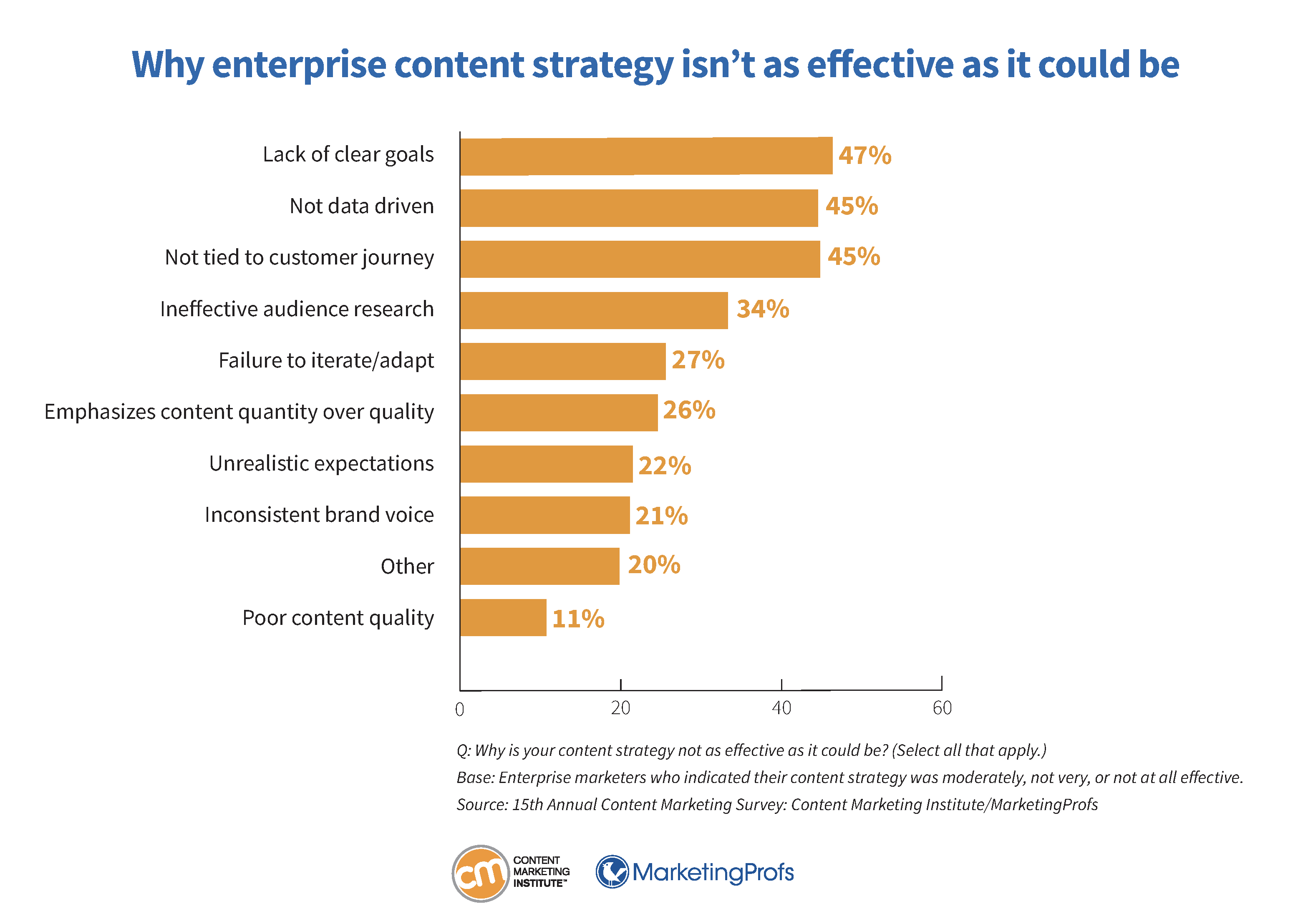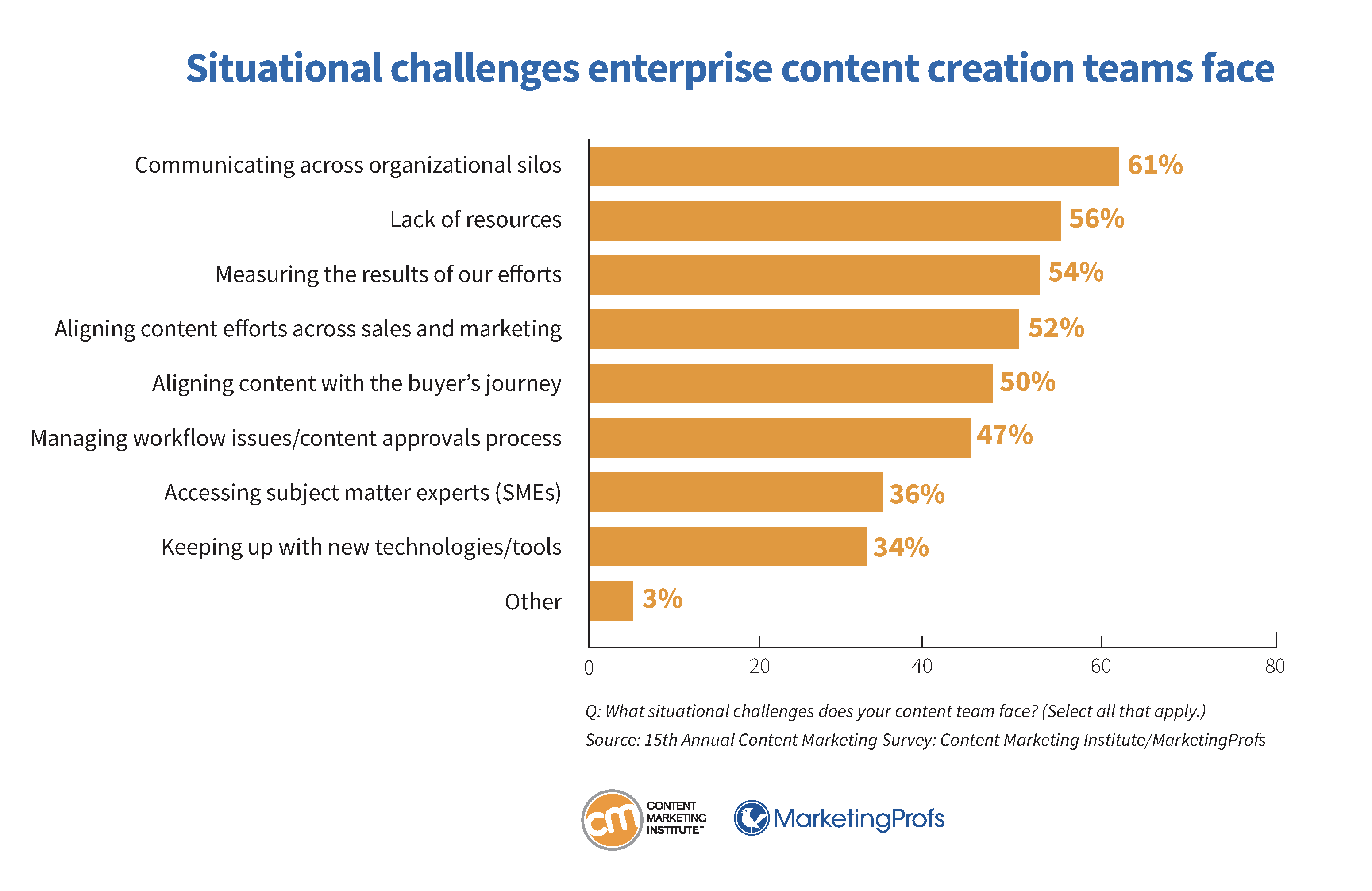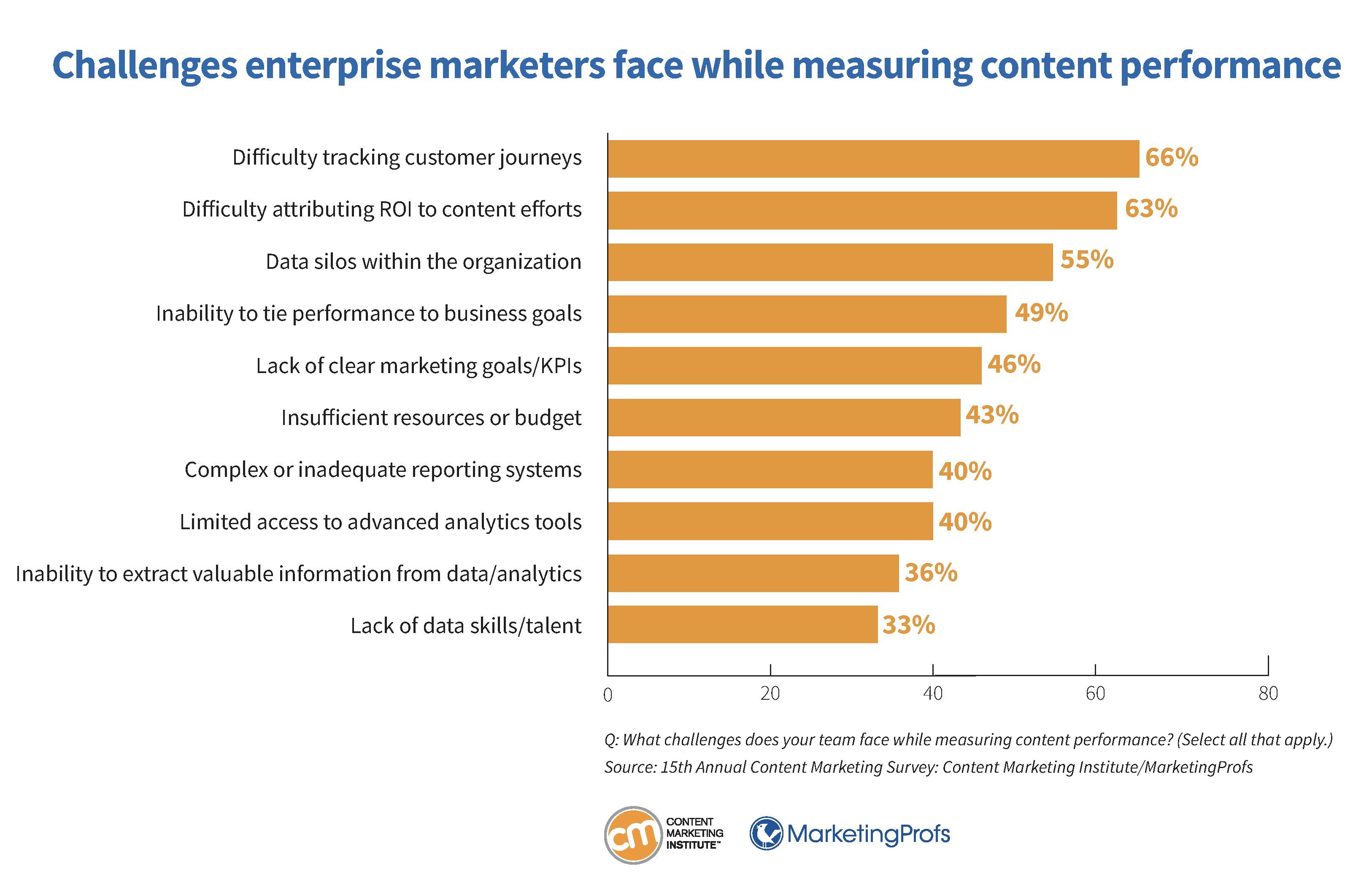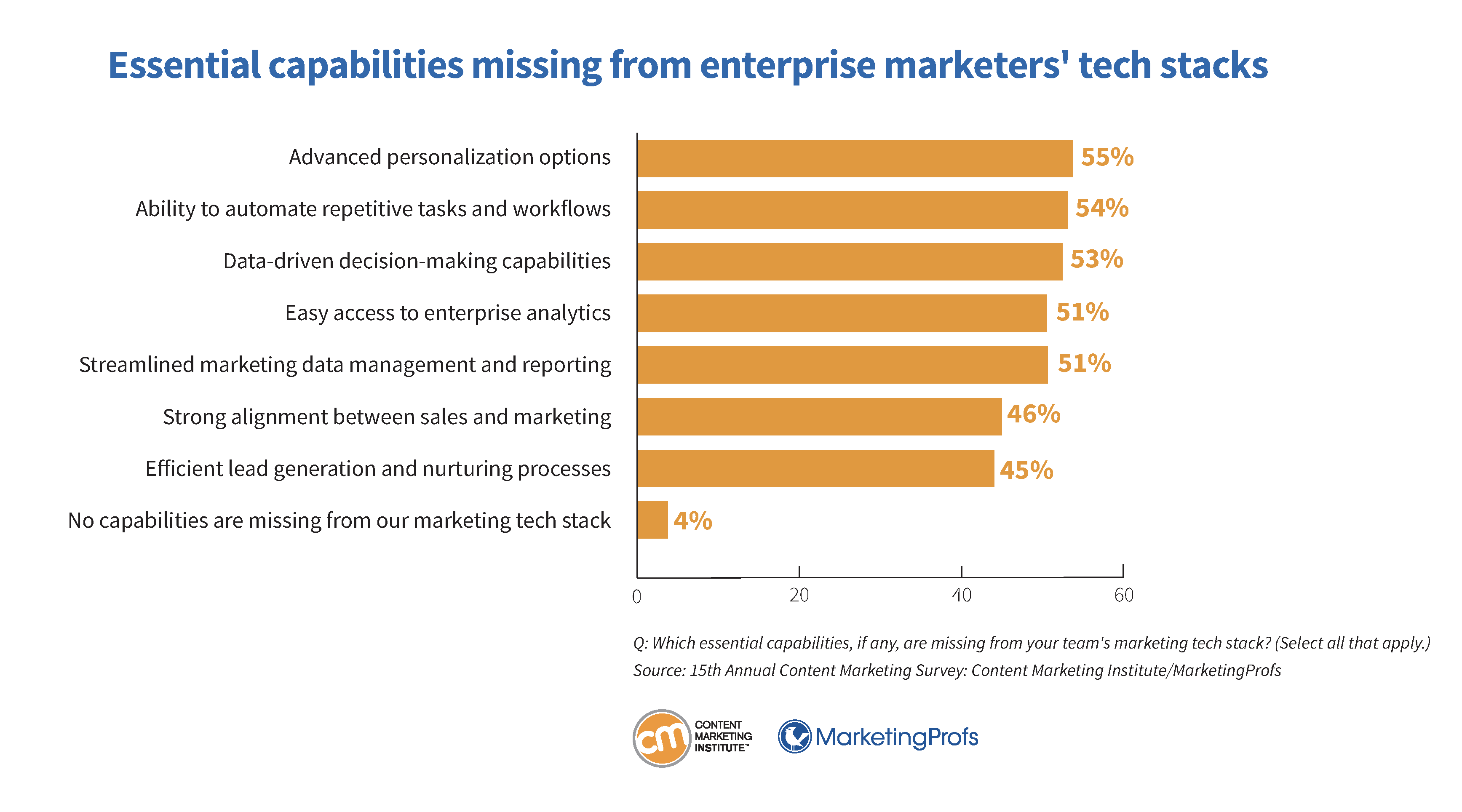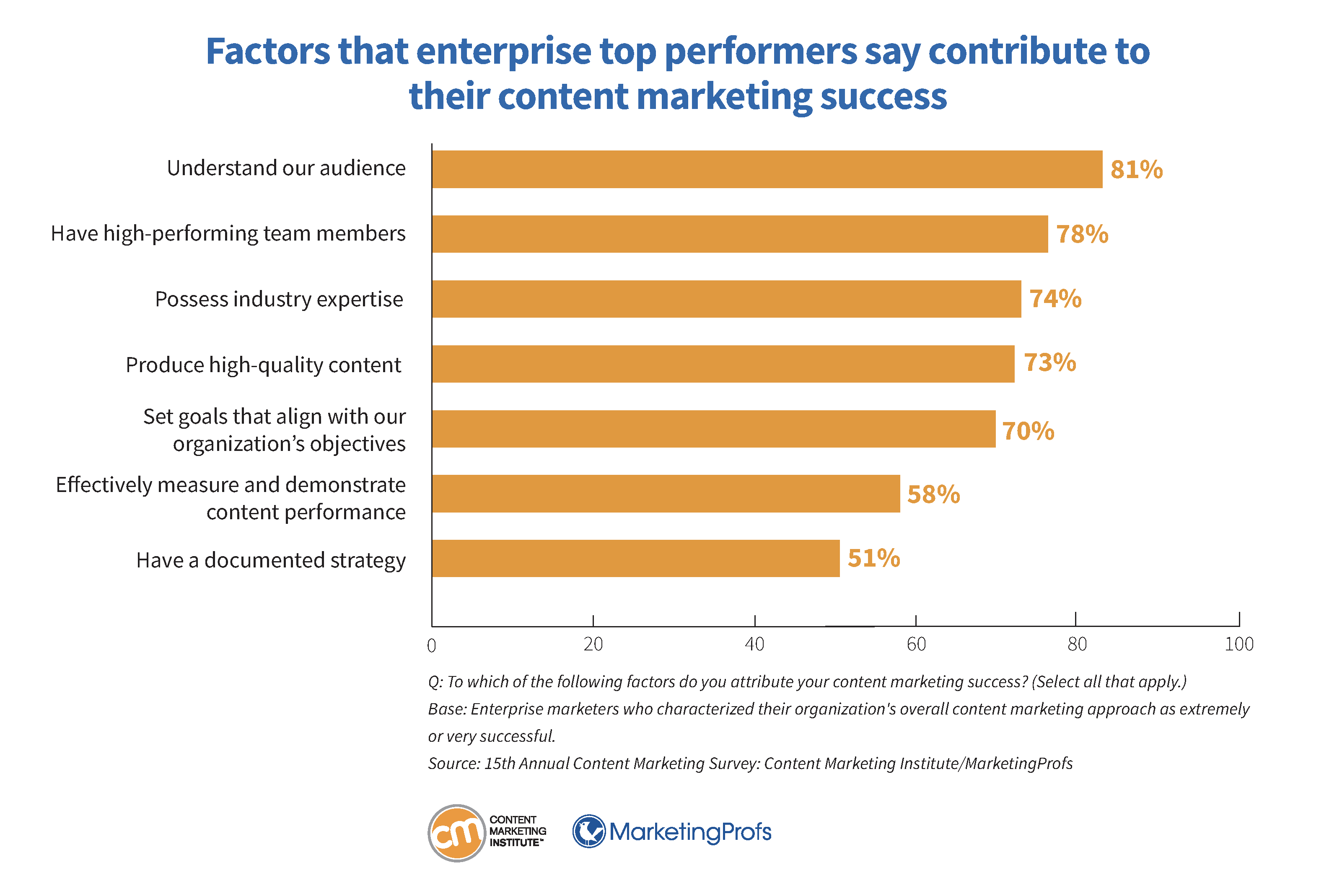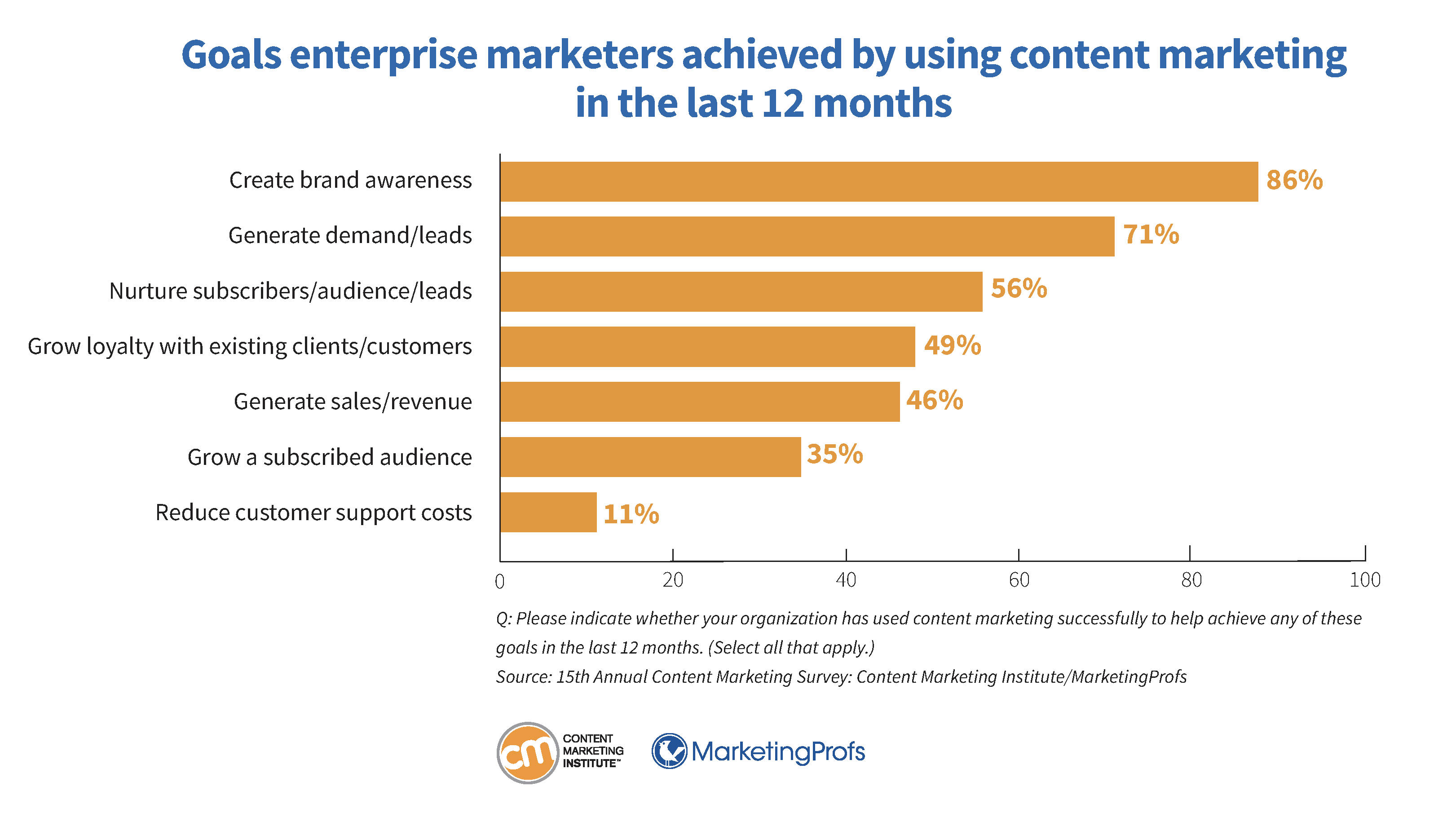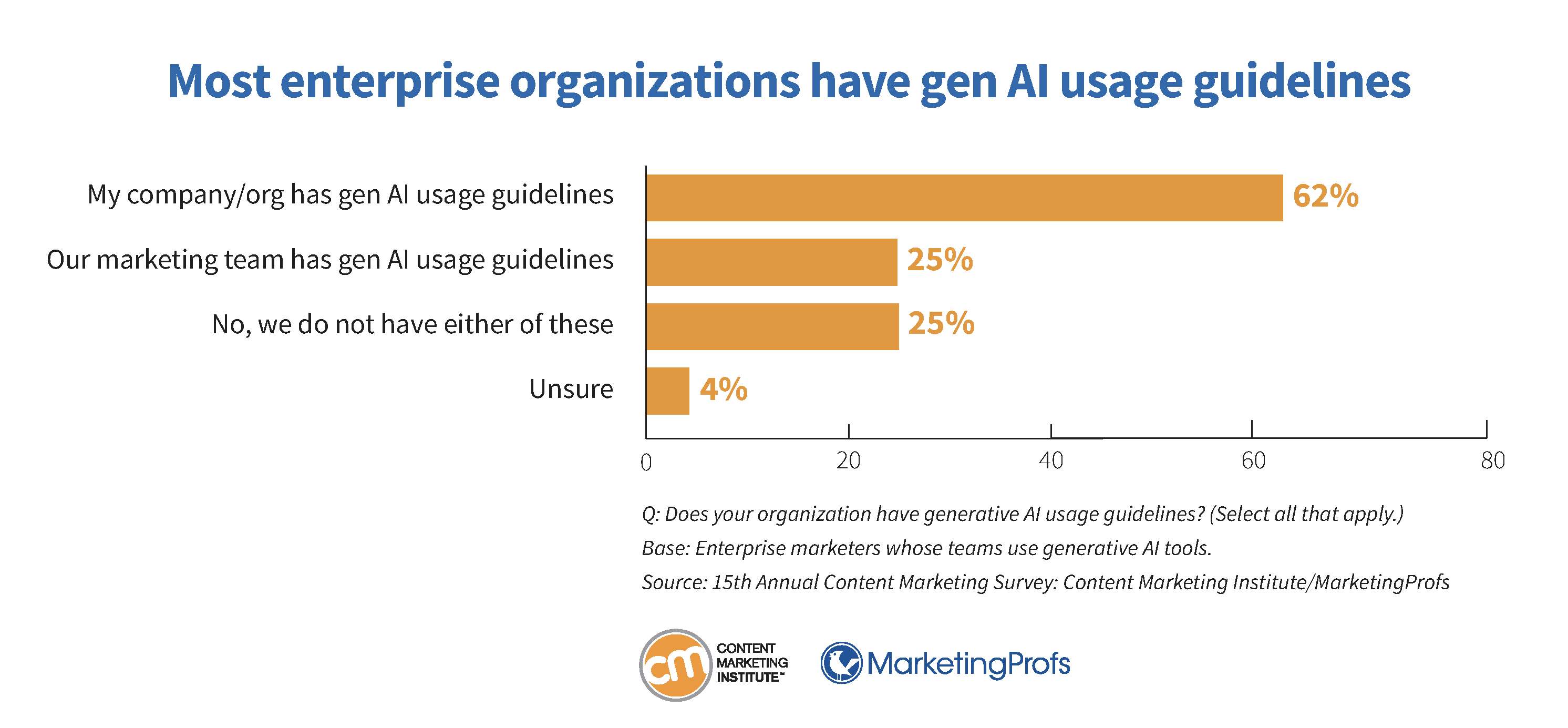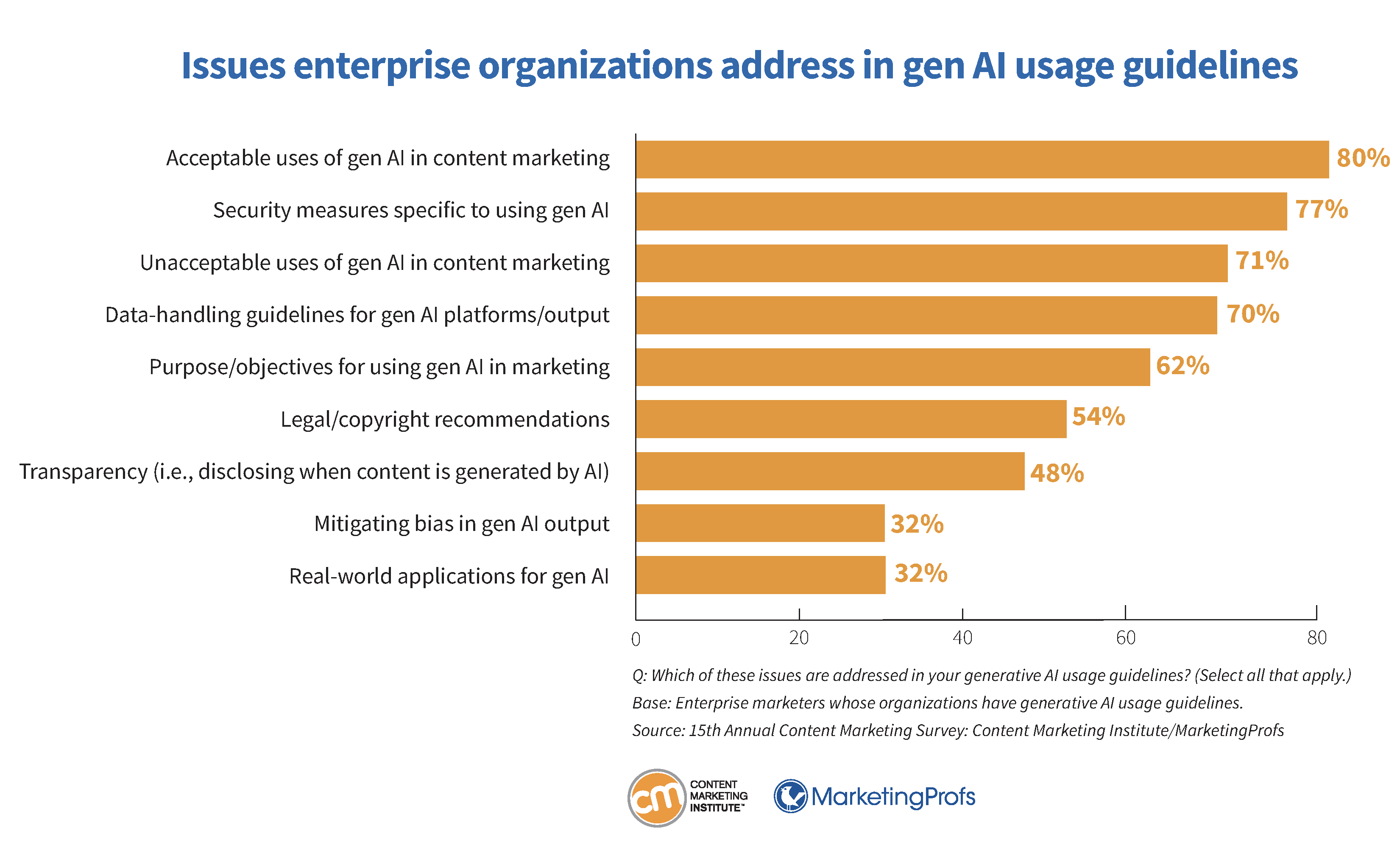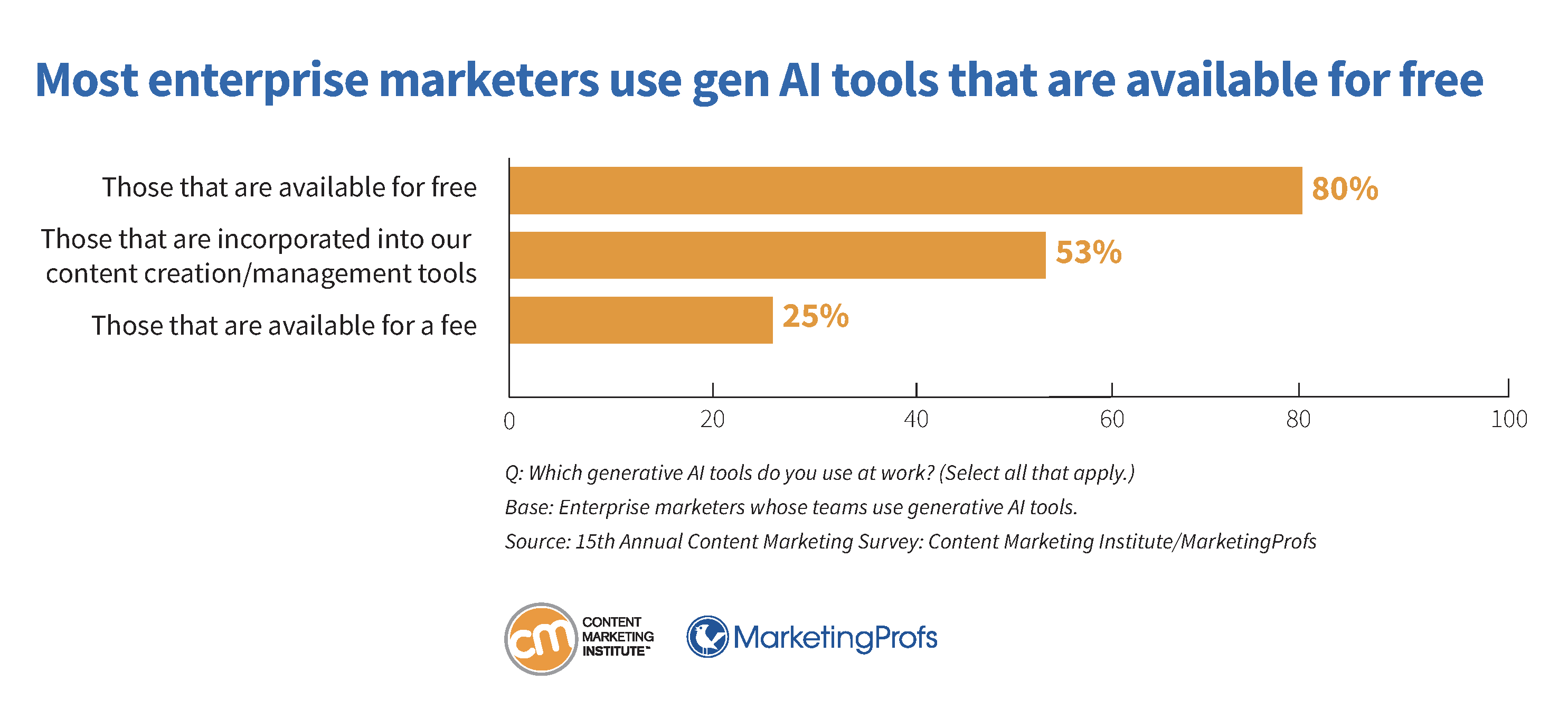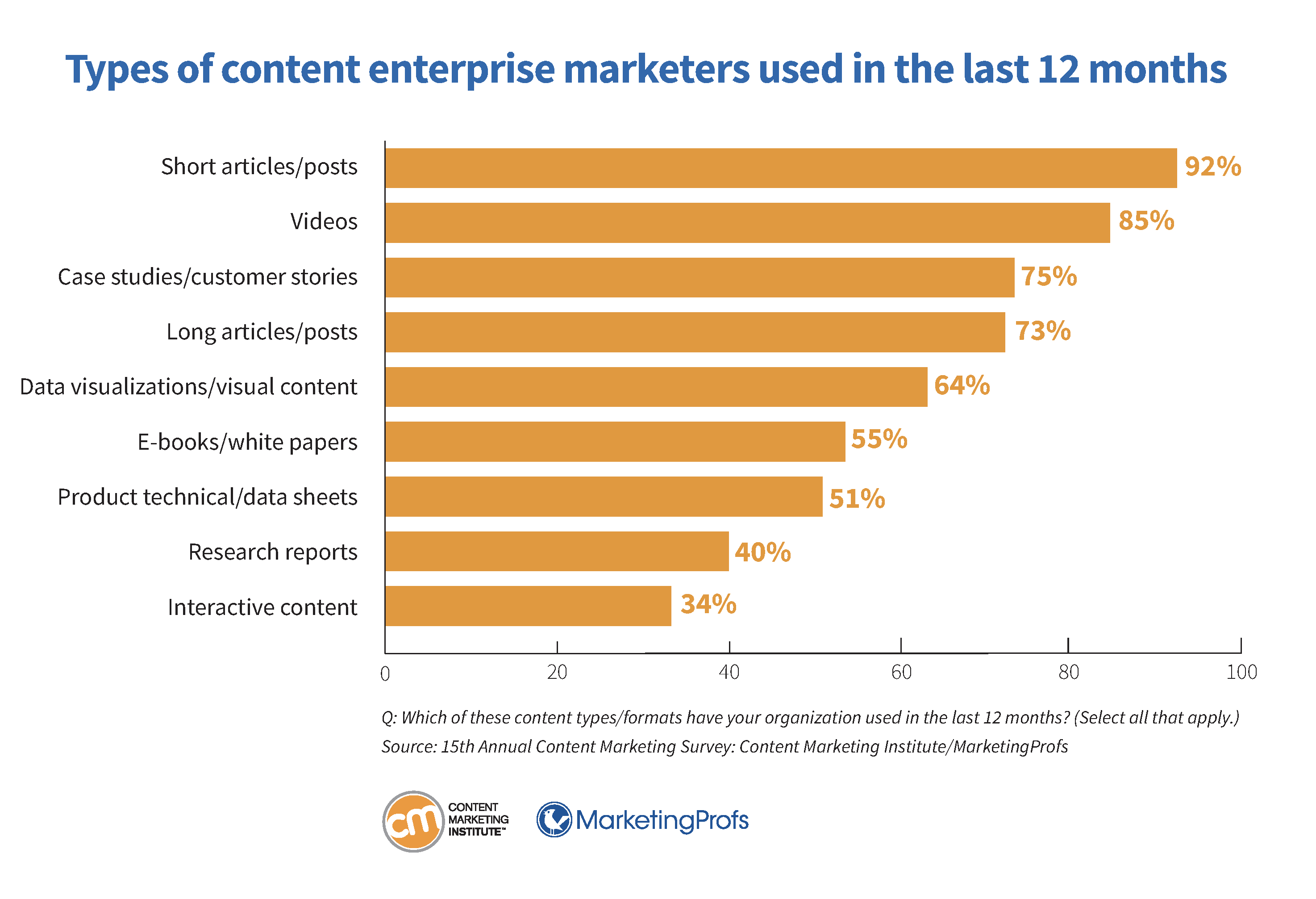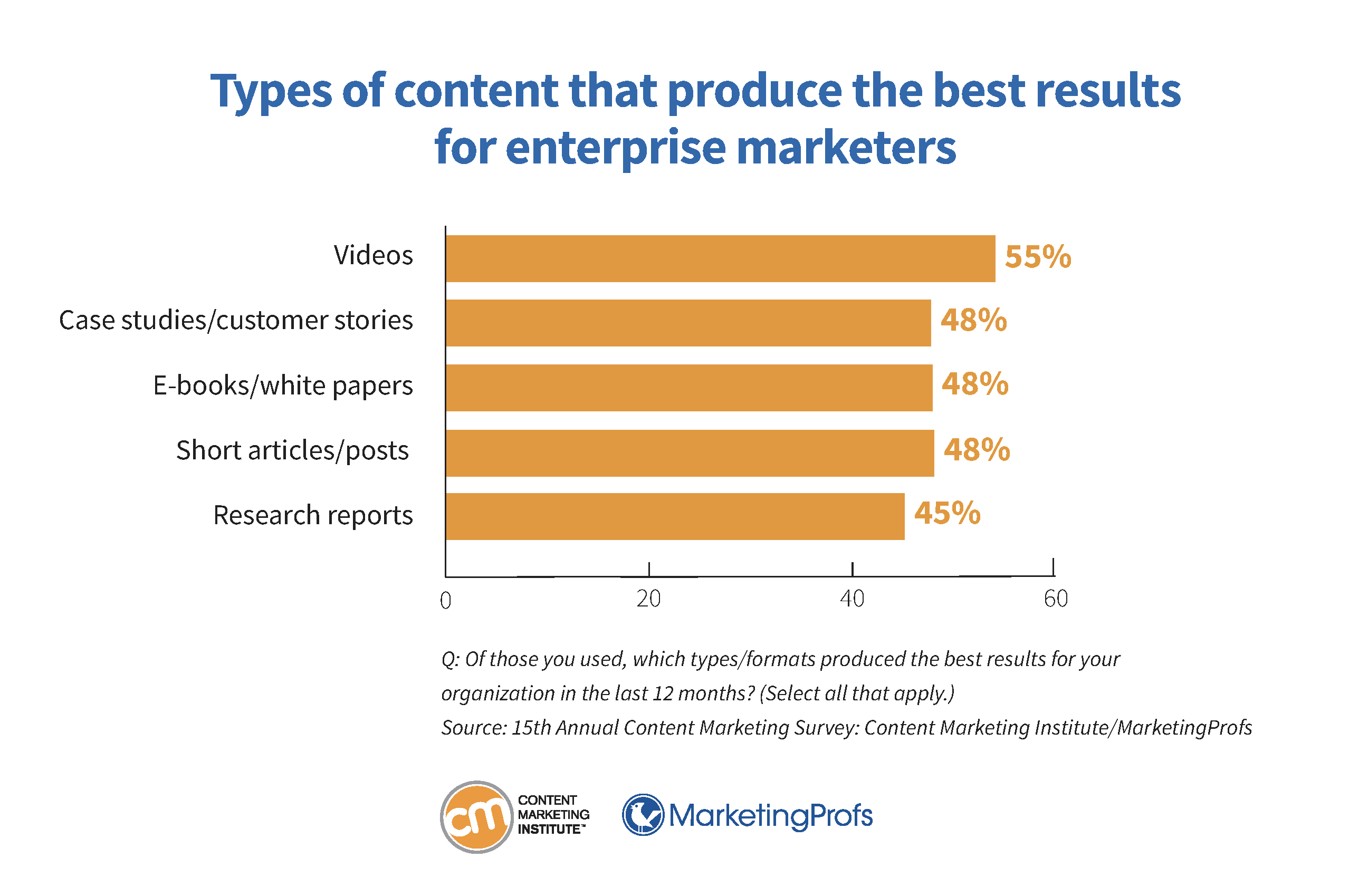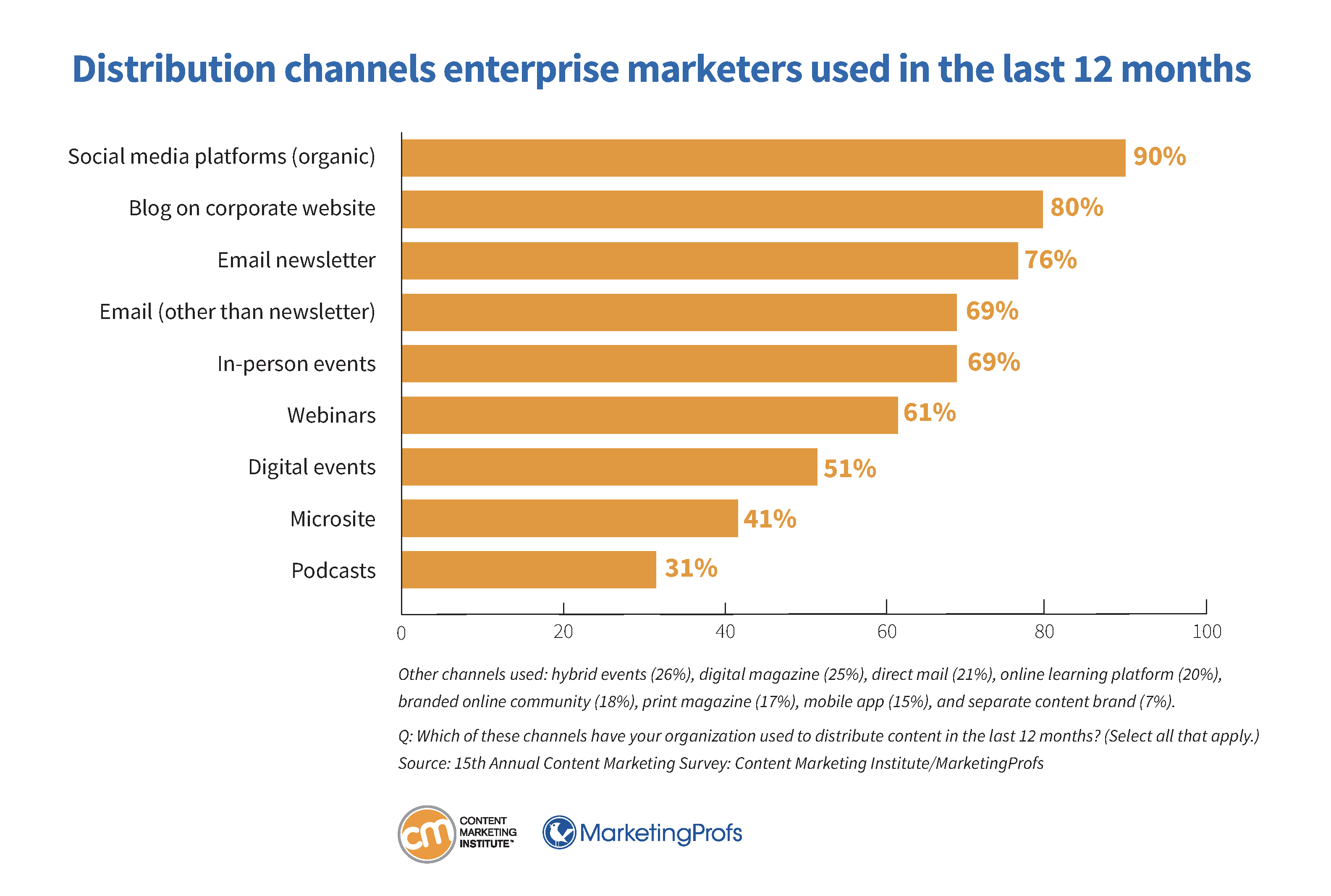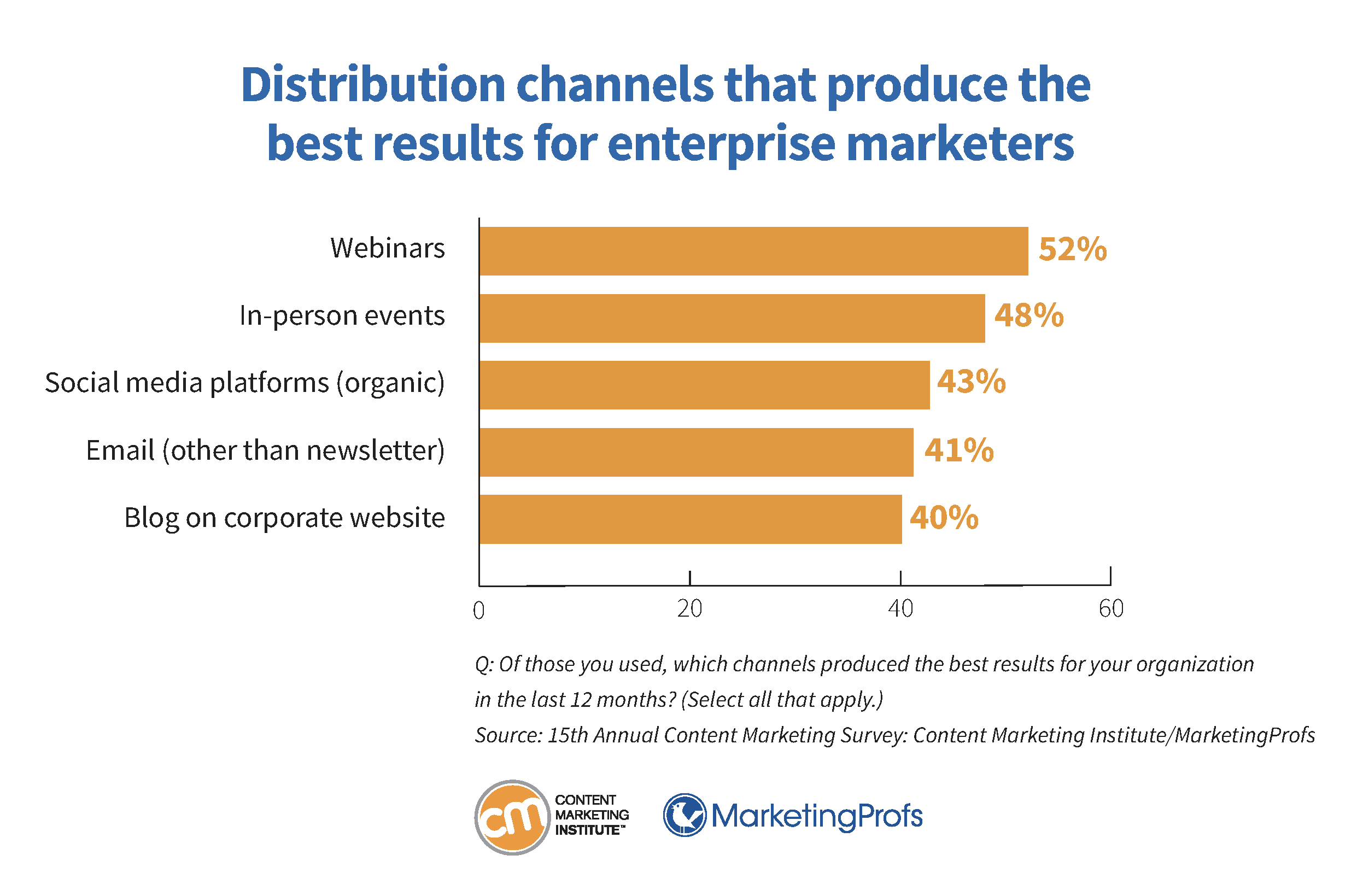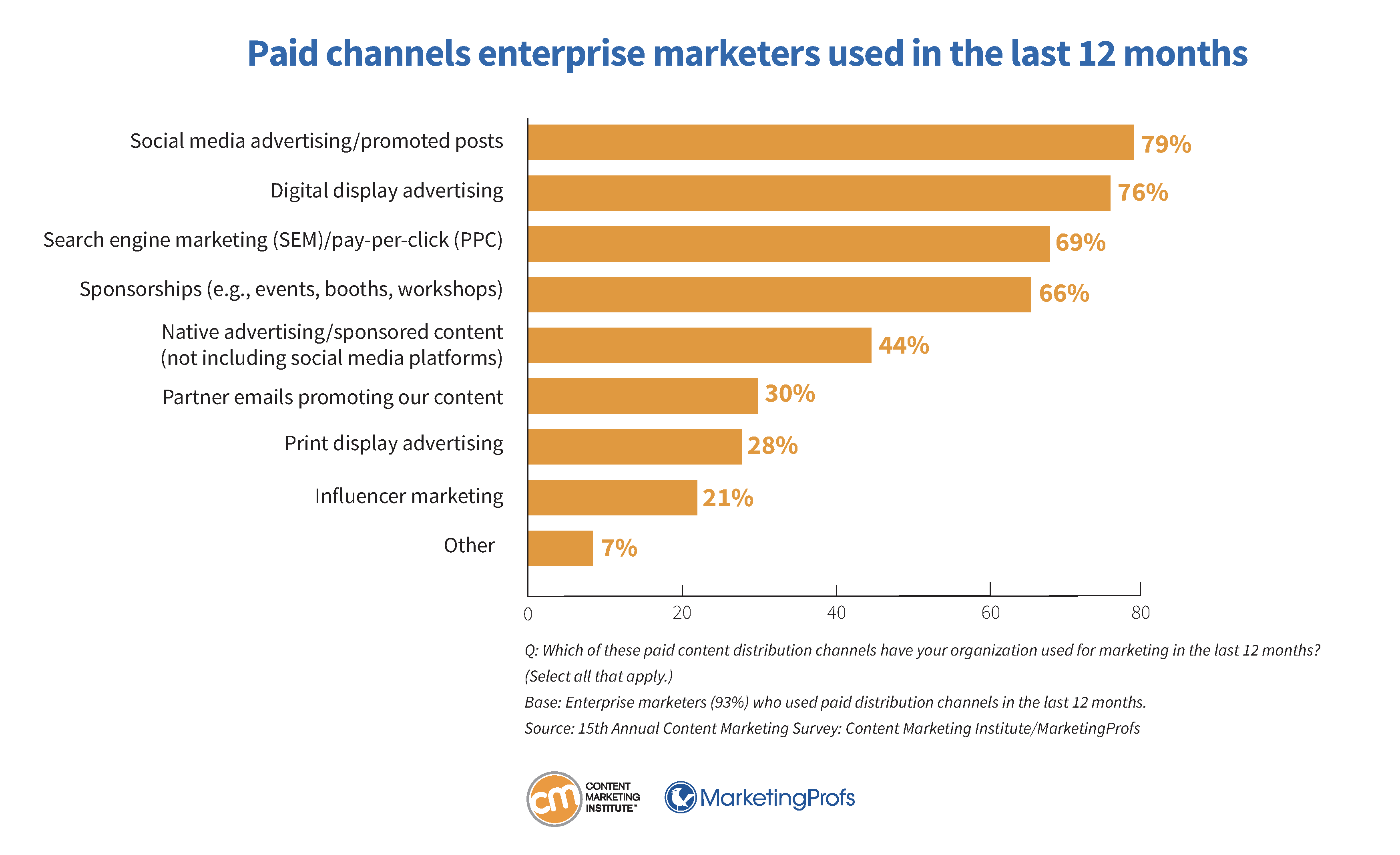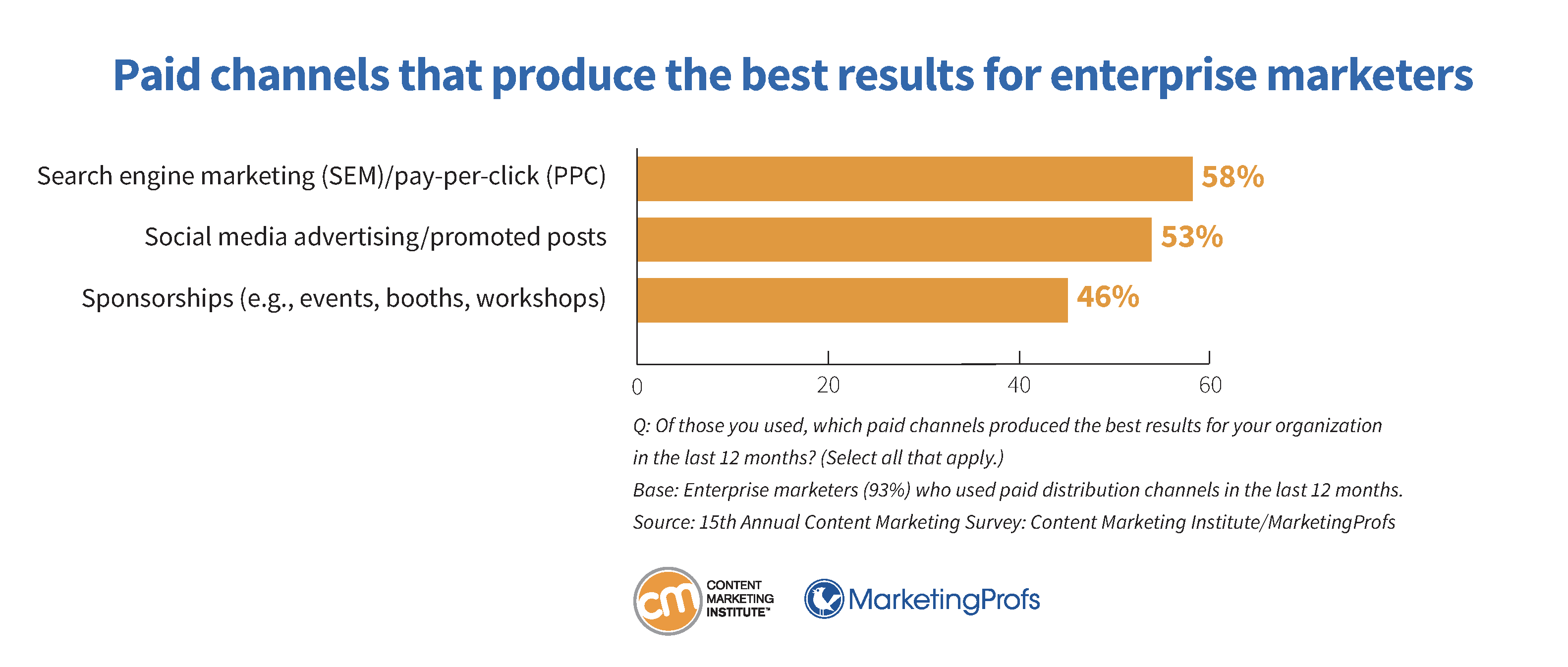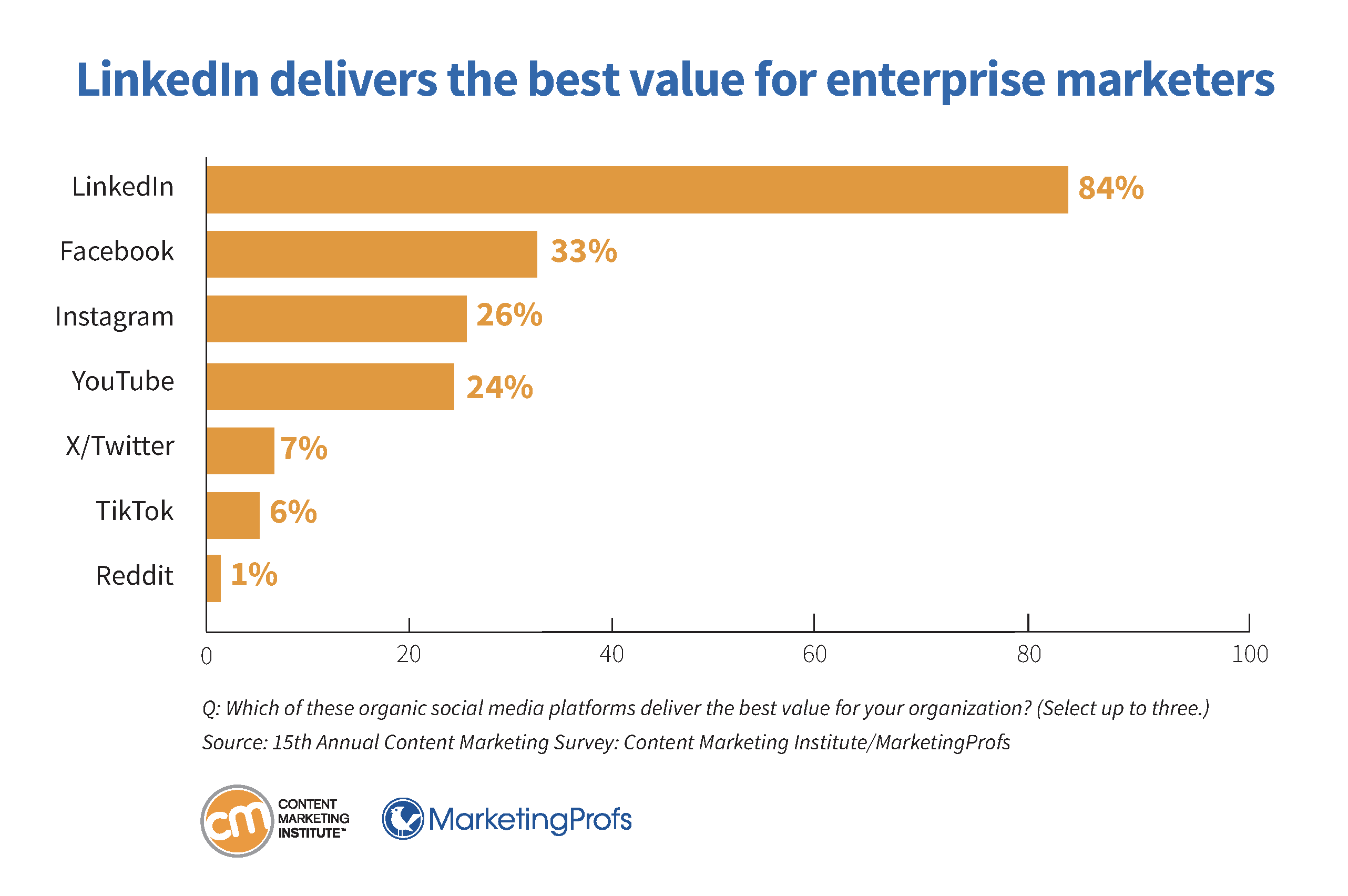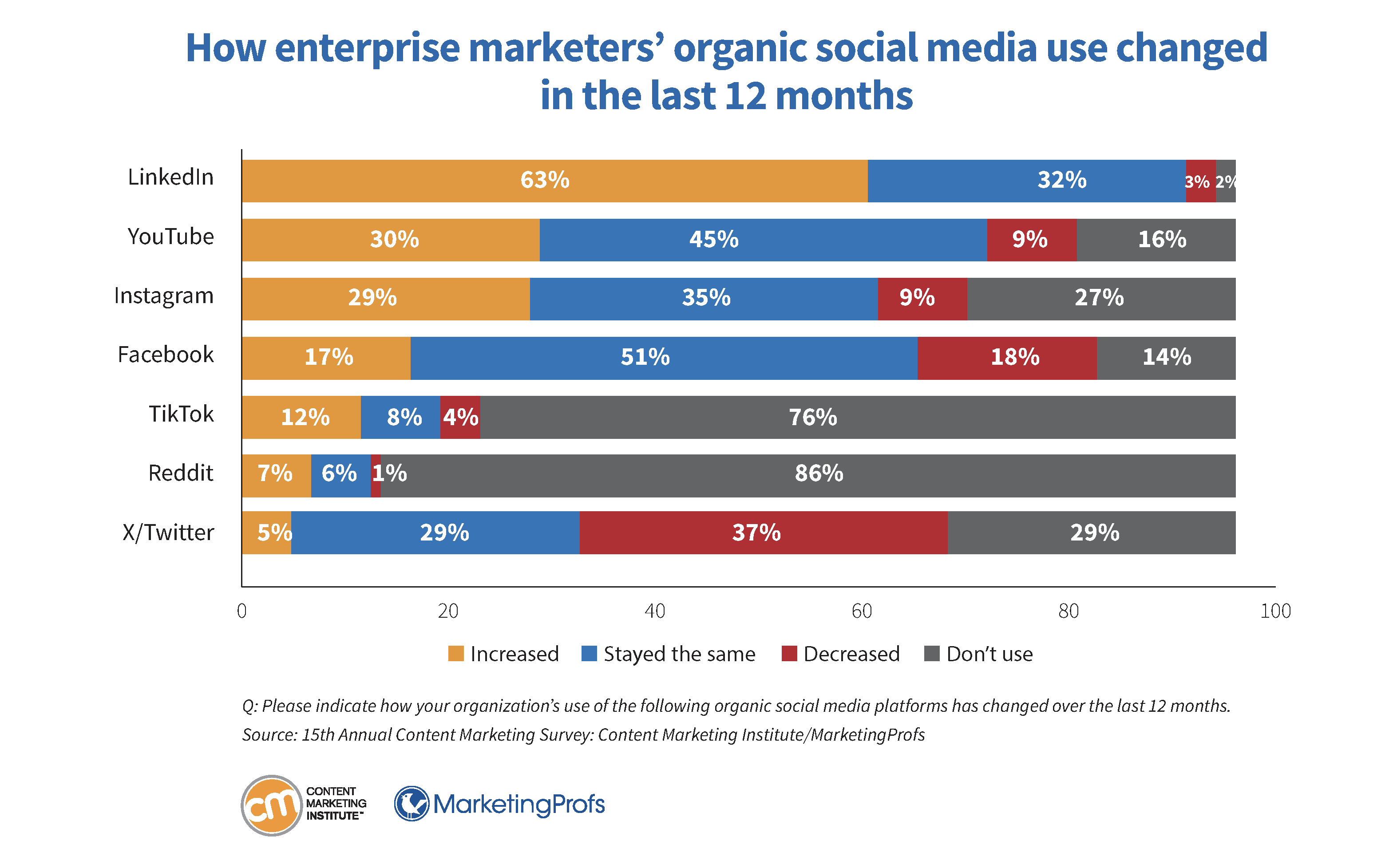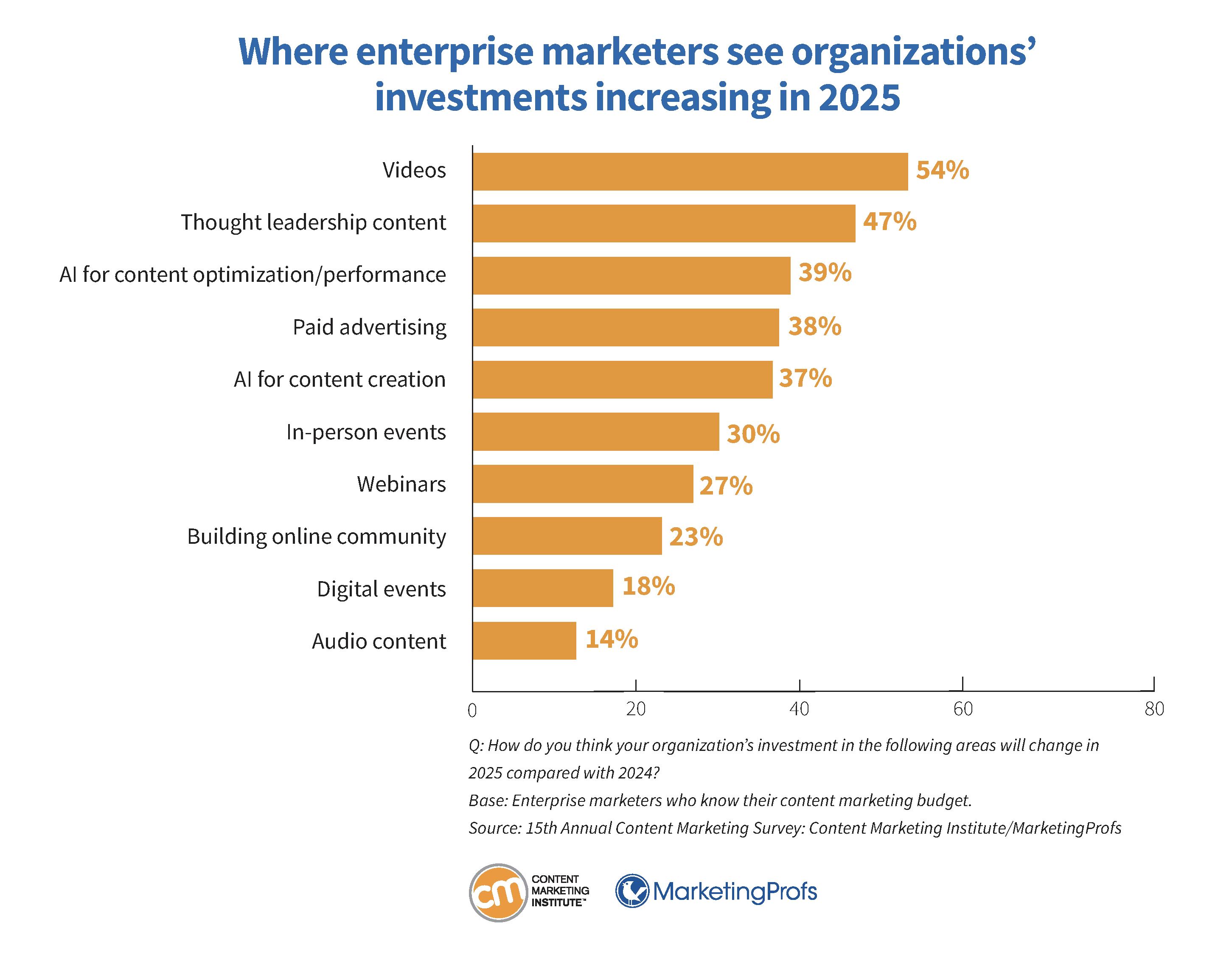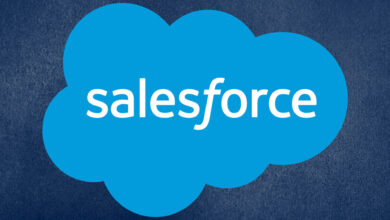Enterprise Content Marketing Benchmarks, Budgets, and Trends: Outlook for 2025

2024 was a “meh” year for content and marketing.
That pronouncement comes from marketers, not grumpy, underwhelmed business execs. Of course, that doesn’t mean great work didn’t happen. Plenty of companies produced impressive content. Just look at these award-winning examples.
Many of the nearly 1,200 marketers surveyed for our annual B2B Content Marketing Benchmarks, Budgets, and Trends study, conducted with MarketingProfs and sponsored by Storyblok, didn’t feel great about their strategies or results.
They didn’t feel terrible, either. They just felt “meh.”
But what if we look only at marketers who work for organizations with more than 1,000 employees? Surely, enterprise marketers with their larger teams and potentially larger budgets think more positively about their work last year?
Unfortunately, they don’t.
Like their B2B peers who work at companies of all sizes, many of the 310 enterprise marketers in the study felt just average about their content strategies.
Let’s dig into why and what factors distinguish enterprise content and marketing success, spending, and other plans for 2025.
What keeps content strategies stuck at ‘moderately’ effective?
An effective strategy underlies any success. Yet only 28% of enterprise marketers say their content strategy is extremely or very effective. Sixty-one percent say it’s moderately effective. Eleven percent say it’s not very effective. The good news is that no one says their strategy is not at all effective.
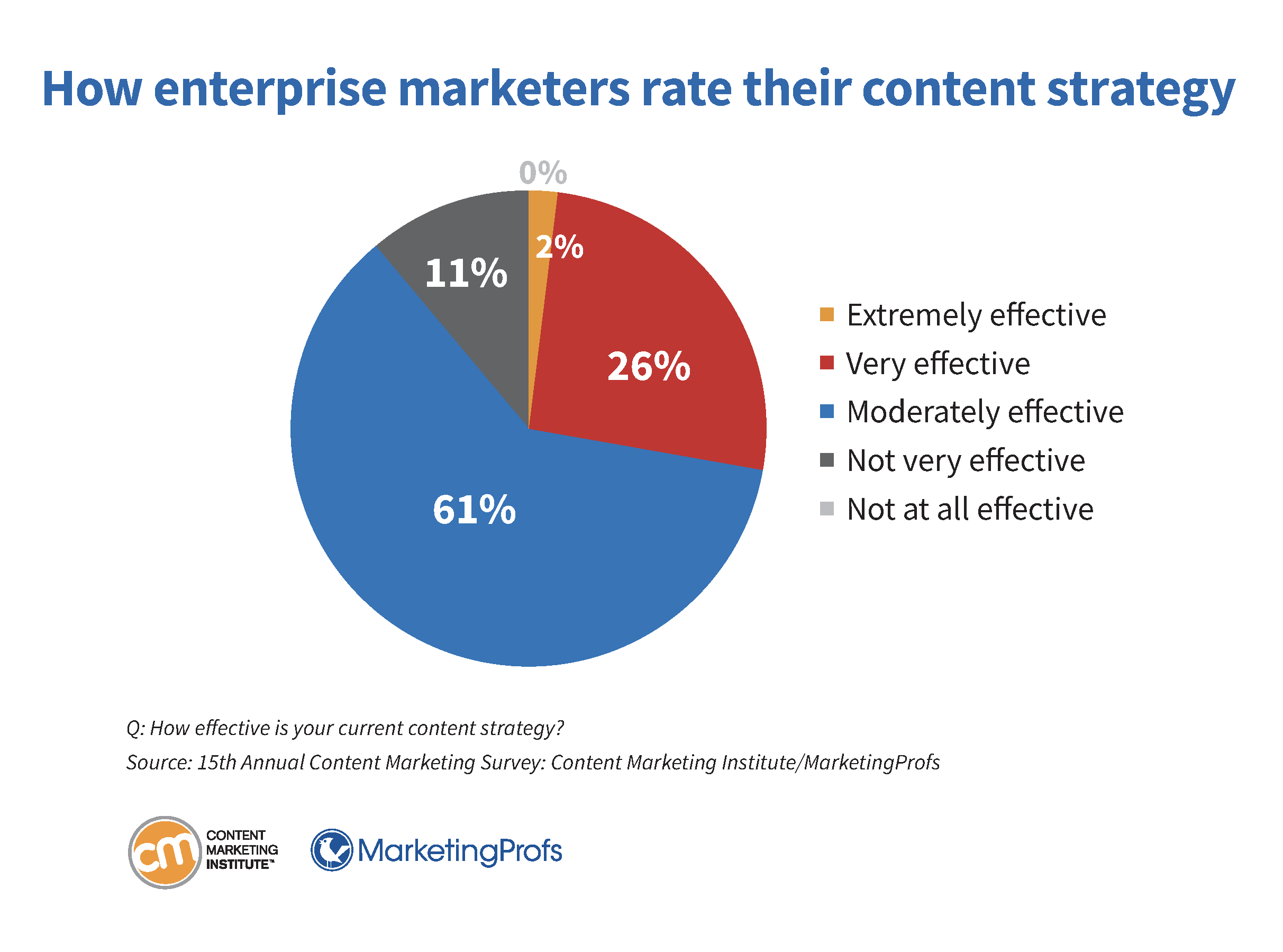
Let’s look at areas where enterprise marketers struggle.
Lack of clear goals
Why do enterprise marketers wrestle with strategy? Forty-seven percent say it’s a lack of clear goals. Forty-five percent say the strategy is not data-driven, and 45% say it is not tied to the customer journey. Other reasons include:
Ineffective audience research (34%)
Failure to iterate/adapt (27%)
Emphasizes content quantity over quality (26%)
Unrealistic expectations (22%)
Inconsistent brand voice (21%)
Other (20%)
Poor content quality (11%)
 Michael Brenner
Michael Brenner
Author & VP of Content, Workday
Michael Brenner, author and vice president of content at Workday, presented a content strategy workshop at Content Marketing World 2024. He is not surprised by this finding: This is a reflection of the sad truth that behind every bad piece of content is an executive who asked for it. Data is always the key because it can show you how well the content lines up to customer needs, including the keywords they use, the topics they are interested in, the campaign assets they need, and the social conversations they are having. Data also shows you what works so you can align the content strategy to the top business goals. Bottom line is content strategies are either aligned to customers’ needs or internal executives’ whims.
Communication issues
As in past years, the most popular non-creation challenge for enterprise marketers is communicating across organizational silos (61%). Next, they cite a lack of resources (56%), which is the most common challenge their B2B peers face.
Other situational challenges include measuring the results of their efforts (54%), aligning content efforts across sales and marketing (52%), and aligning content with the buyer’s journey (50%). Fewer than half cite:
Managing workflow issues/content approvals process (47%)
Accessing subject matter experts (36%)
Keeping up with new technologies/tools (34%)
Other (3%)
Creation challenges
More than half (58%) of enterprise marketers say crafting content that prompts a desired action (e.g., conversion) is a challenge, making the new response in this year’s survey the most common hurdle.
The second most cited challenge – which was No. 1 last year – is creating the right content for the audience. However, enterprise marketers have made strides, with 49% reporting it’s a challenge vs. 61% the previous year. They’ve also done a better job of:
Differentiating their content (47% for 2025 report vs. 57% the previous year)
Creating content consistently (37% for 2025 report vs. 46% the previous year)
Optimizing for SEO (37% for 2025 report vs. 42% the previous year)
Creating quality content (30% for 2025 report vs. 46% the previous year)
Content repurposing (47%) and creating enough content (34%) are new challenge options in this survey.
Content performance measurement
Forty-eight percent of enterprise marketers agree that their organization measures content performance effectively (12% neither agree nor disagree, 38% disagree, and 2% don’t measure).
That’s not to say they don’t encounter challenges: Sixty-six percent face difficulty tracking customer journeys, and 63% have difficulty attributing ROI to content efforts. Other challenges include:
Data silos within the organization (55%)
Inability to tie performance to business goals (49%)
Lack of clear marketing goals/KPIs (46%)
Insufficient resources or budget (43%)
Complex or inadequate reporting systems (40%)
Limited access to advanced analytics tools (40%)
Inability to extract valuable information from data/analytics (36%)
Lack of data skills/talent (33%)
Scalable models for content creation are missing
Nearly half of enterprise marketers say they do not have a scalable model for content creation. Thirty-three percent say they do, and 21% are unsure.
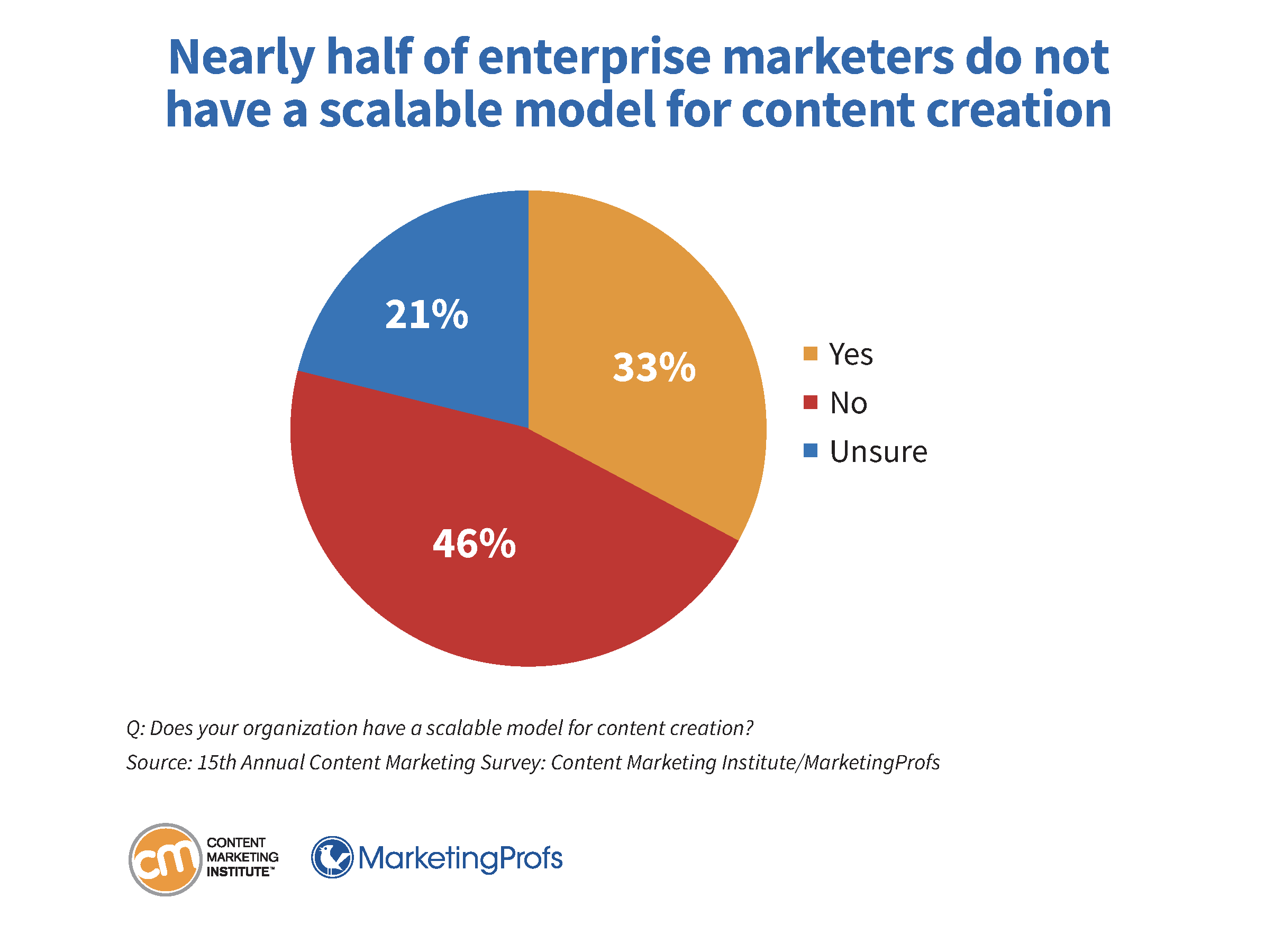
Among those who do have a scalable model, 40% say the model creates the desired outcomes. Fifty-five percent say it does not create the desired outcomes, “but we’re getting there.” Four percent say no, “We have a long way to go.” Two percent are unsure.
 Shannon Doubleday
Shannon Doubleday
Director of Content Marketing, Hilton
In their Content Marketing World 2024 session, Calming Content and Creative Chaos with Strategic Content Mastery, Cathy McKnight, chief problem solver and lead analyst, Seventh Bear, and Shannon Doubleday, director of content marketing, Hilton, demonstrated how important a repeatable process model is to content marketing success.
 Cathy McKnight
Cathy McKnight
Chief Problem Solver, Seventh Bear
By treating content as a strategic function and getting the model in place, Hilton was able to go from multiple strategies to a centralized function, from purchased stock footage to hours of reusable assets, from 10K hours watched to 100K hours watched (organic content), and double its content schedule by using content assets in an intelligent way.
Lack of effective content management technology
The needle didn’t move much in this report on whether organizations have the right technology to manage content across the organization. Only 22% say yes (same as the previous year). Thirty-eight percent say, “No, we have the technology but aren’t using it to its potential” (up from 34% the previous year). Thirty percent say, “No, we haven’t acquired the right technology,” (down from 34% the previous year). And like the previous year, 10% are unsure.
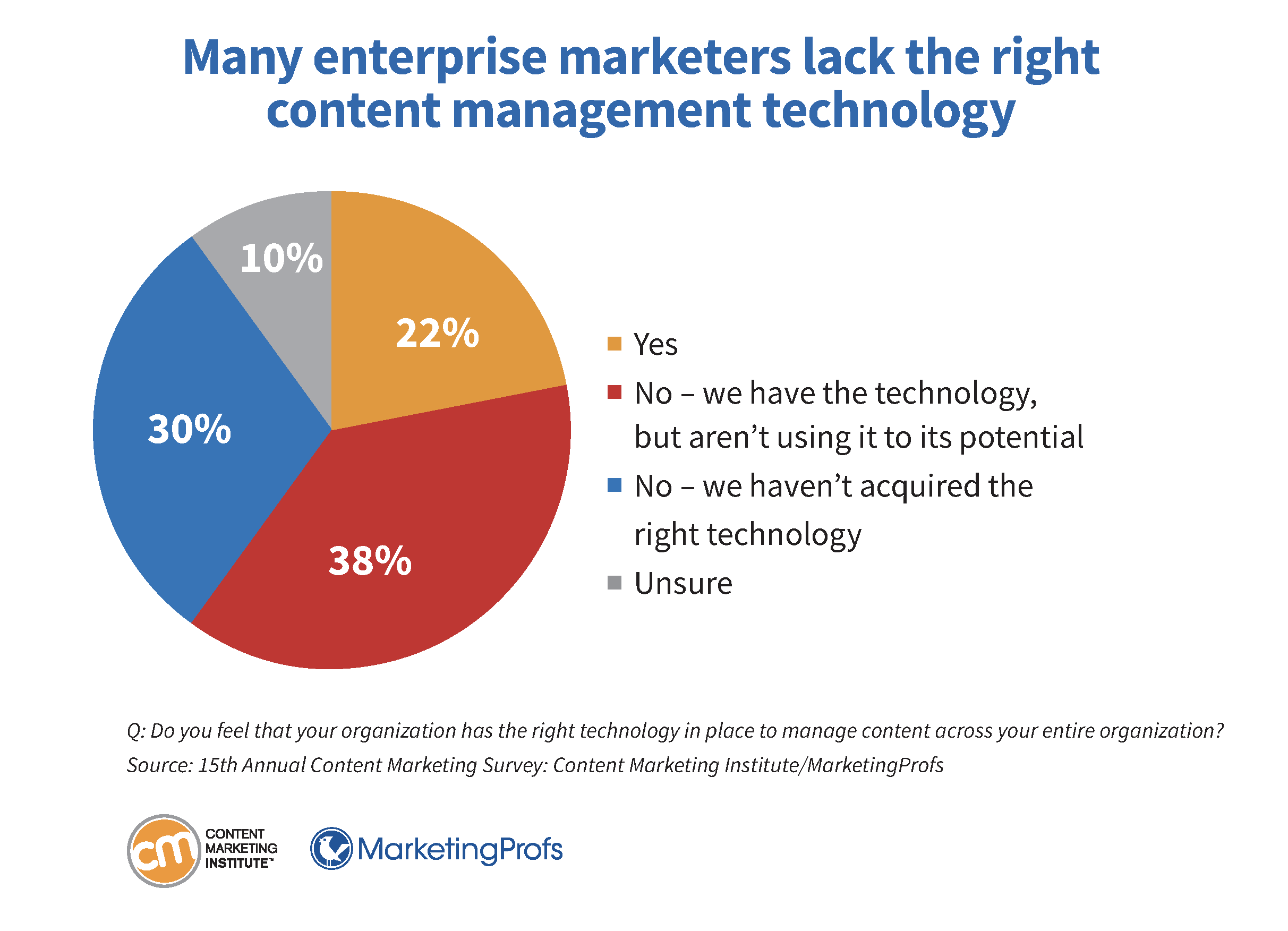
Specifically, 55% of enterprise marketers say their marketing tech stacks lack advanced personalization options. A similar number (54%) say their tech doesn’t have the ability to automate repetitive tasks and workflows, and 53% cite a lack of data-driven decision-making capabilities. Other missing capabilities include:
Easy access to enterprise analytics (51%)
Streamlined marketing data management and reporting (51%)
Strong alignment between sales and marketing (46%)
Efficient lead generation and nurturing processes (45%)
Four percent say no capabilities are missing from their marketing tech stacks.
Top performers understand their audiences
With all the challenges enterprise marketers face, how many are achieving success with their content marketing?
Given that almost two-thirds of enterprise marketers say their content strategy is only moderately effective, it’s no surprise that 22% characterize the success of their organization’s content marketing approach in the last 12 months as extremely or very successful. Fifty-seven percent say it was moderately successful. Sixteen percent say it was minimally successful. One percent says it was not at all successful, and 4% are unsure.
When asked what they attribute their content marketing success to, 81% of the extremely and very successful enterprise marketers (aka “top performers”) say understanding their audience. Other factors include:
High-performing team members (78%)
Industry expertise (74%)
High-quality content (73%)
Goals that align with our organization’s objectives (70%)
Effective measurement and demonstration of content performance (58%)
Documented strategy (51%)
 Michelle Lazette
Michelle Lazette
Marketing Strategist, Federal Reserve Bank
The importance of understanding your audience is something Michelle Lazette, marketing strategist at the Federal Reserve Bank of Cleveland, knows well: Our audiences today aren’t captive in ways audiences used to be. Their only news source isn’t the newspaper that lands on their lawn with ads placed by and stories informed by organizations like ours. They have choice upon choice upon choice, and where one creator isn’t delivering content that helps, entertains, or otherwise serves them, they’re going to find another who is.
I’m reminded of a conference speaker who asked those in the audience to pretend they were responsible for marketing socks. “Not one person needs your socks,” she said. “They need their feet to be warm.” This inspires me to ask via surveys, brainstorms with colleagues, monitoring the landscape, and more what does our audience need and want, and how can that Venn diagram of their needs overlap with how we want to show up for others?
We created our long-form storytelling about how access to child care impacts the economy because community members told our staff that some people who want to work can’t because they don’t have care for their dependents. And our study of audience needs and wants doesn’t end once a story is published: In monitoring reader behaviors with a different piece, we realized asking folks to click more than once for the multimedia experience we promised them turned away half our would-be readership (ugh!). The lesson there (for us, and maybe you) is when we tell our audience to come see photographs, firsthand stories, and data visualizations, we need to deliver them directly to that work, not a landing page.
Goals achieved
Regardless of their overall success, most enterprise marketers do an impressive job using content marketing to create brand awareness (86% say they’ve done that in the last 12 months). Other goals achieved include:
Generate demand leads (71%)
Nurture subscribers/audiences/leads (56%)
Grow loyalty with existing clients/customers (49%)
Grow a subscribed audience (35%)
Reduce customer support costs (11%)
Team structure: How the work gets done
This year, we asked enterprise marketers if they have a dedicated content marketing team or staff person. Eighty-six percent say yes. Who handles content marketing for the remaining 14%? Most say “marketing.”
Of the 86% with dedicated teams/people, 7% have one person. Thirty-five percent have a small team (two to five people), 23% have a medium team (six to nine people), and 35% say they have a large team (10 or more people).
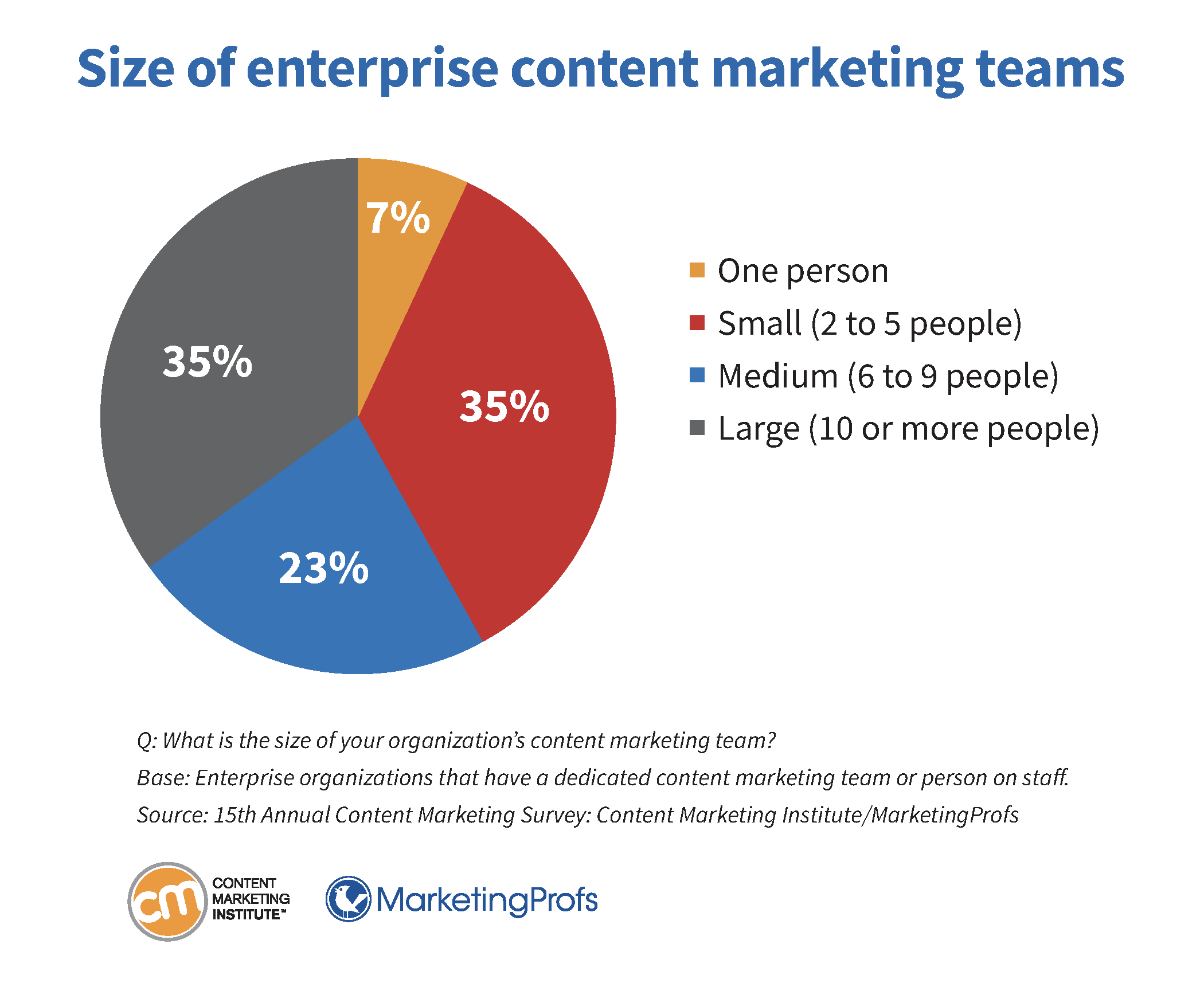
While most enterprise marketers (64%) expect their content marketing team size to stay the same in 2025, 24% expect it to increase, 5% think it will decrease, and 7% are unsure.
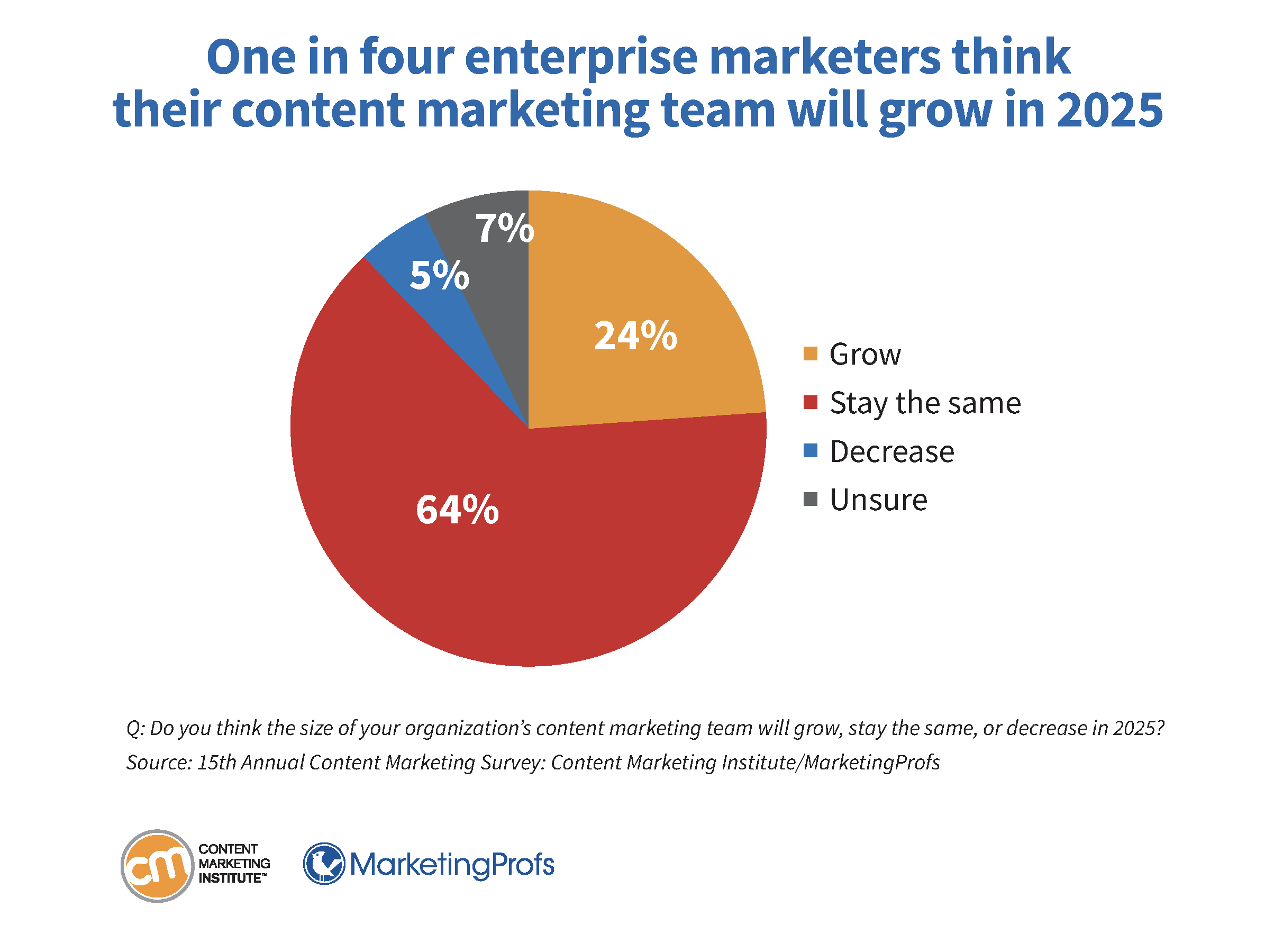
When asked why they thought their team size would increase, we mostly heard that growth would require more marketing support. And while 25% say they’ve noticed job anxiety within their organizations because of AI (see below), no one says they expect job cuts resulting from AI’s implementation.
AI use
Speaking of AI, 75% of enterprise marketers report that their organizations are using it — up from 58% the previous year.
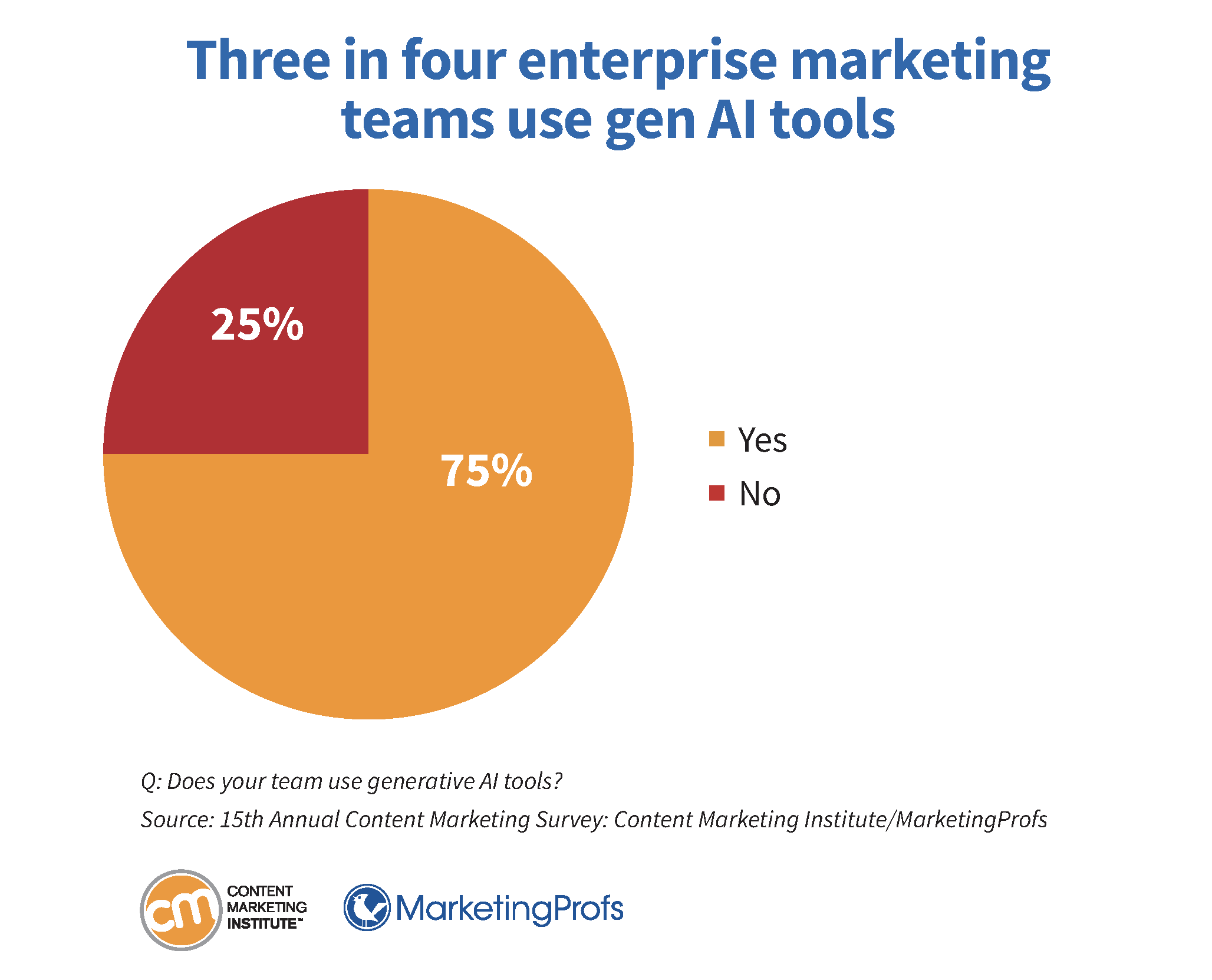
With the increased use came an increase in generative AI usage guidelines: 62% of respondents say their organization has guidelines vs. 36% the previous year. In addition, 25% say their marketing team has its own set of guidelines (25% say they don’t have either, and 4% are unsure.)
What do the usage guidelines address? Most (80%) say they address acceptable uses of generative AI in content marketing, 77% cite security measures specific to using generative AI, 71% say unacceptable uses of generative AI in content marketing, and 70% cite data-handling guidelines for generative AI platforms/output. Other elements include:
Purpose/objectives for using generative AI in marketing (62%)
Legal/copyright recommendations (54%)
Transparency (48%)
Mitigating bias in generative AI output (32%)
Real-world applications for generative AI (32%)
In terms of maturity, most enterprise teams (57%) experiment with AI on an ad hoc basis. Another 15% say AI is integrated into their daily processes/workflows. Twenty-eight percent say their team does not formally use AI, and staff may choose to use it individually.
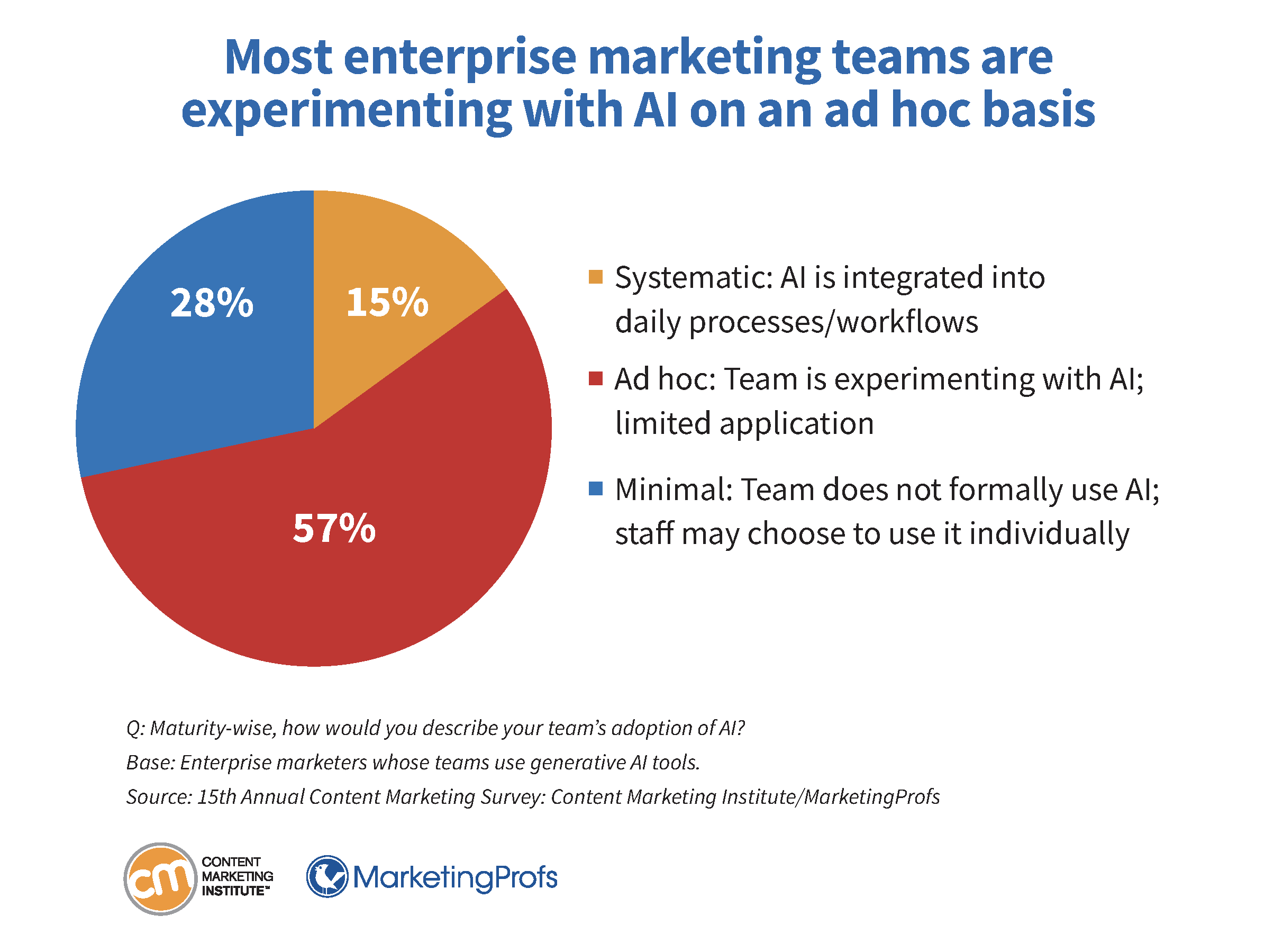
As they said last year, most enterprise marketers use free generative AI tools (80% this year vs. 87% last year). However, we see a big jump in those who say that tools are embedded in their content creation/management systems (53% this year vs. 33% the previous year). About the same percentage of enterprise marketers (25%) as last year pay for tools.
This year, we asked about marketers’ trust and perception of quality in AI outputs. Most enterprise marketers (70%) place a medium level of trust in them, while 3% report a high level, and 27% say a low level. No one says they have no trust in AI outputs.
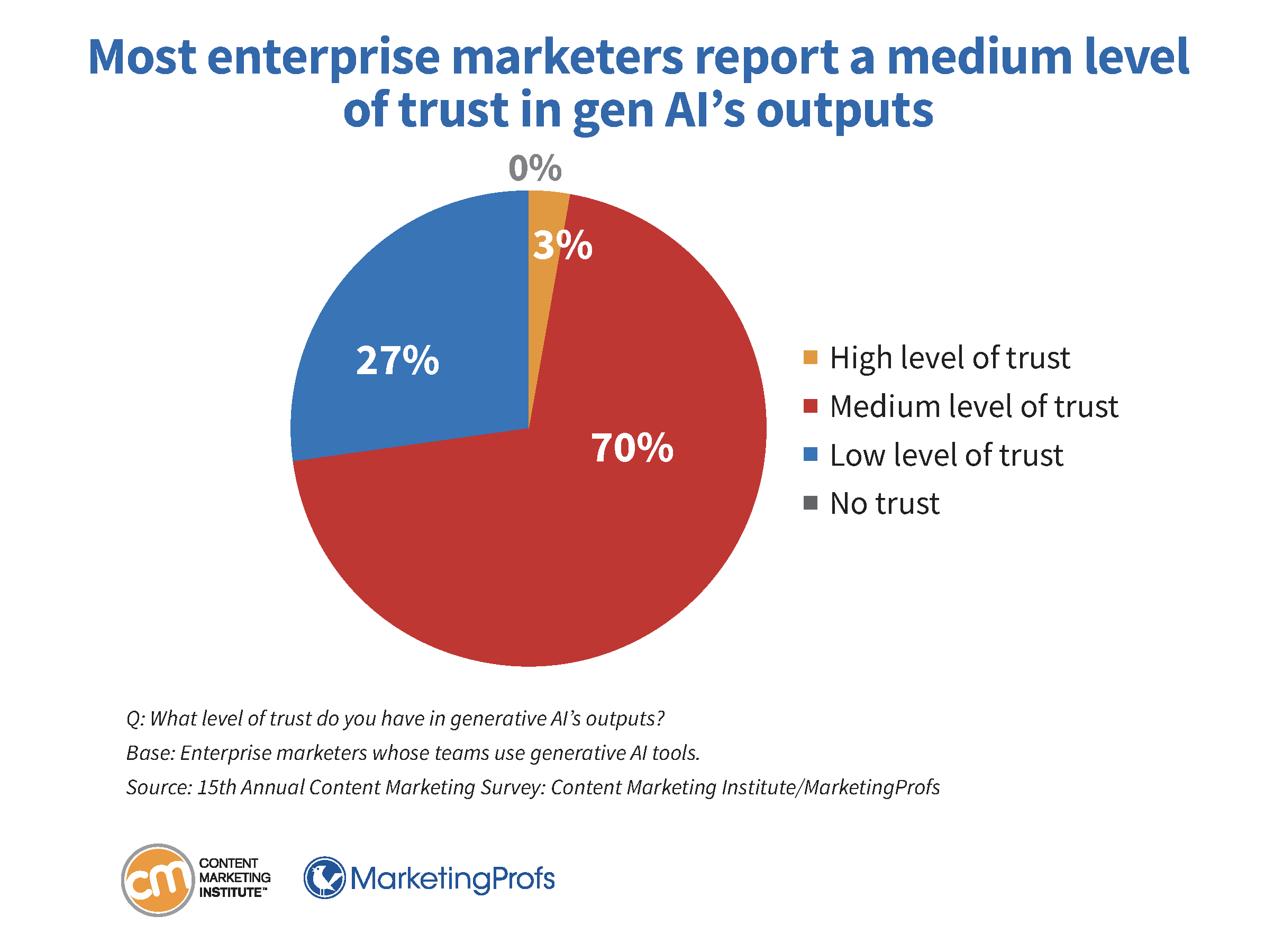
Enterprise marketers have mixed thoughts about the quality of content generated by AI. Sixty percent say it’s excellent, very good, or good, and 40% say it’s fair or poor.

Half of enterprise marketers surveyed (50%) say the impact of AI tools includes having fewer tedious tasks. Forty-three percent notice improved content optimization, and 40% experience more efficient workflows. Other effects include:
Improved creativity (34%)
Job anxiety (25%)
Changing job requirements (20%)
Lower-quality content (14%)
More personalized content (13%)
Nine percent say they don’t notice any impact.
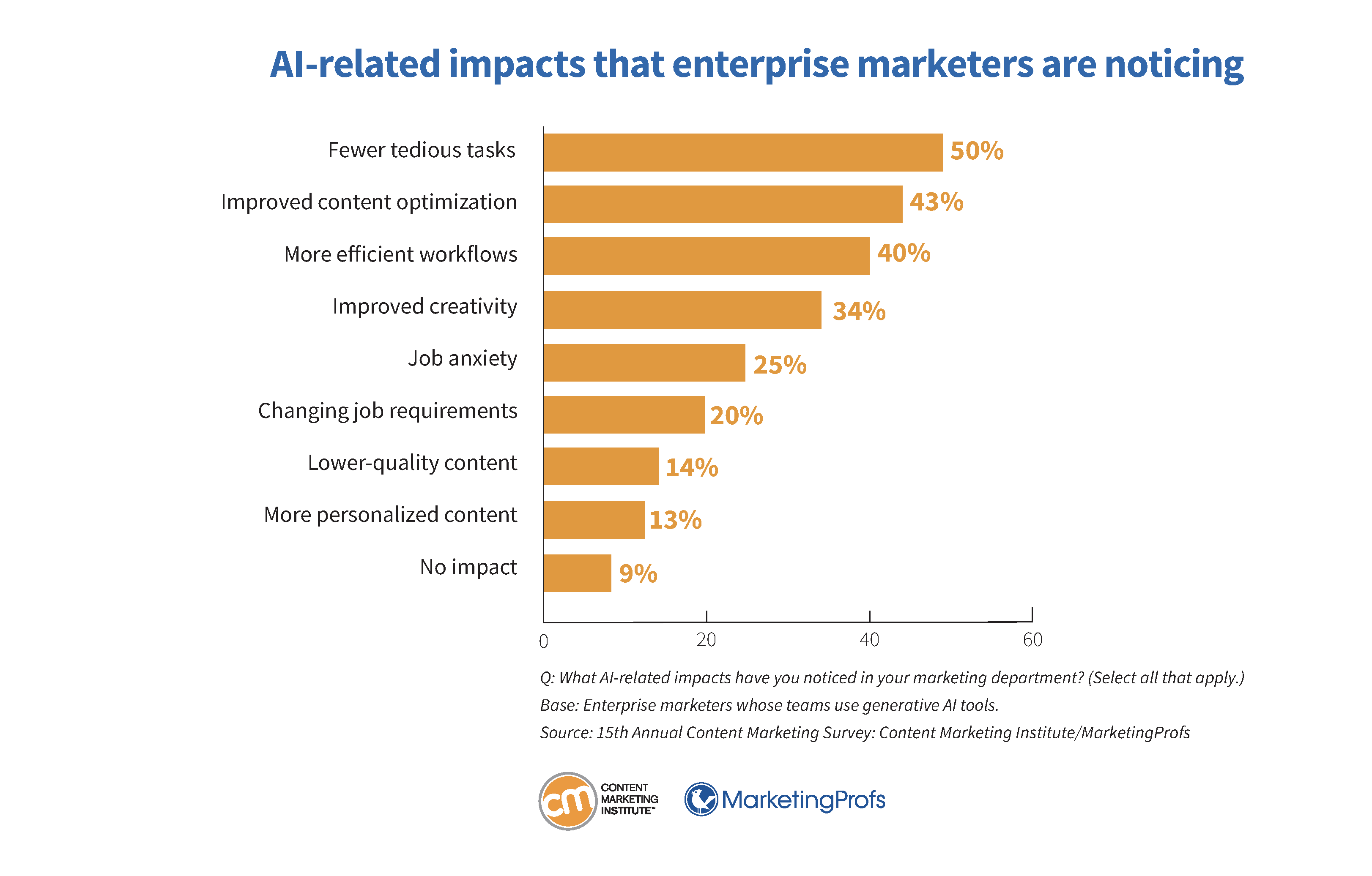
Looking to 2025, 57% of enterprise marketers say their organizations would place a high or medium priority on AI-powered automation. Seventeen percent say it would be a low priority. Only 11% say it was not a priority, and 15% were unsure.
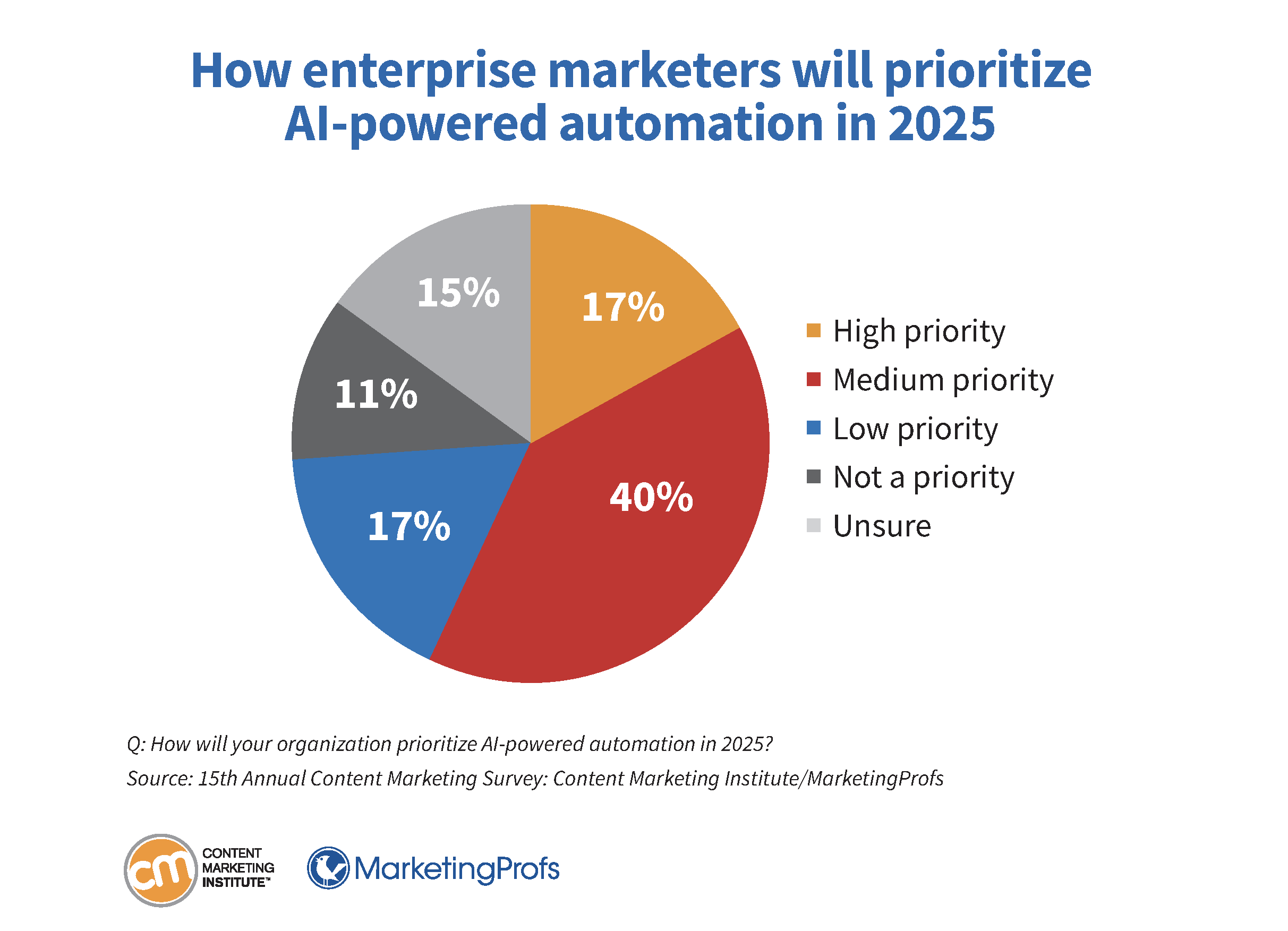
Content tactics, distribution channels, and social media
Now that you understand better how enterprise marketers see strategy, encounter challenges, gain success, and experience AI, let’s explore the kinds of content produced and how it gets to audiences.
Short articles replace videos as the most popular content type
How did enterprise marketers reach their audiences in the previous 12 months?
Short articles/posts (92%) replaced videos (85%) as the most popular type of content. (Last year, 94% reported using videos.) Use of other content types stayed consistent with the previous year, with 75% using case studies/customer stories, 73% publishing long articles/posts, 64% using data visualizations/visual content, 55% doing e-books/white papers, 51% developing product technical/data sheets, 40% creating research reports, and 34% crafting interactive content.
As they did last year, most enterprise marketers say videos produce good results (55%), followed by case studies/customer stories (48%), e-books/white papers (48%), short articles/posts (48%), and research reports (45%).
Social media platforms, blogs, and email favored for distribution
Enterprise marketers’ distribution channels also stayed consistent year over year. Ninety percent use organic social media platforms, 80% use blogs on corporate websites, 76% use email newsletters, 69% use email, 69% use in-person events, 61% use webinars, 51% use digital events, 41% use microsites, and 31% use podcasts.
Lesser-used channels include hybrid events (26%), digital magazines (25%), direct mail (21%), online learning platforms (20%), branded online communities (18%), print magazines (17%), mobile apps (15%), and separate content brands (7%).
Like the previous year, enterprise marketers say their effective distribution channels include webinars (52%) and in-person events (48%). Forty-three percent say organic social media platforms are effective, 41% say email is effective, and 40% say blogs are effective.
Almost all use paid distribution channels
Ninety-three percent of enterprise marketers use paid distribution channels. Here again, use has stayed consistent when compared to the previous year. Seventy-nine percent use social media advertising/promoted posts, 76% tap into digital display advertising, 69% invest in search engine marketing (SEM) and pay per click (PPC), and 66% engage in sponsorships. Far fewer use native advertising (44%), partner emails (30%), and print advertising (28%). Twenty-one percent use influencer marketing, a new option in this year’s survey. Seven percent use other methods.
As we saw the previous year, the three most popular effective paid channels are SEM/PPC (58%), social media advertising/promoted posts (53%), and sponsorships (46%).
LinkedIn provides the best value
Like their B2B peers, enterprise marketers say that LinkedIn provides the best value for their organization. Facebook came in at 33%, followed by Instagram (26%), YouTube (24%), X/Twitter (7%), TikTok (6%), and Reddit (1%).
X use continues to decline
Enterprise marketers’ social media use patterns are similar to the previous year with one notable exception: Those who use X decreased by eight percentage points (71% this year vs. 79% the previous year).
LinkedIn: 63% increased, 32% stayed the same, 3% decreased, and 2% don’t use
YouTube: 30% increased, 45% stayed the same, 9% decreased, and 16% don’t use
Instagram: 29% increased, 35% stayed the same, 9% decreased, and 27% don’t use
Facebook: 17% increased, 51% stayed the same, 18% decreased, and 14% don’t use
TikTok: 12% increased, 8% stayed the same, 4% decreased, and 76% don’t use
Reddit: 7% increased, 6% stayed the same, 1% decreased, and 86% don’t use
X/Twitter: 5% increased, 29% stayed the same, 37% decreased, and 29% don’t use
Budgets and spending
Thirty-nine percent of enterprise marketers say they expect their content marketing budgets to increase in 2025 compared with 2024. Forty-one percent think it will stay the same. Fourteen percent expect it will decrease, and 6% are unsure.

As far as tactical budgets go, 54% of enterprise marketers expect their organization to increase investment in video in 2025 (67% thought that in the previous year). Other notable decreases from the previous year include in-person events (30%), a 22-percentage-point drop from the previous year, and audio content (14%), which dropped nine percentage points from the previous year.
New options on this year’s survey list, such as investments in AI for content optimization/performance (39%) and AI for content creation (37%), are expected to increase.
Areas where enterprise marketers anticipate budget increases as they did last year include thought leadership (47%), paid advertising (38%), webinars (27%), building online community (23%), and digital events (18%).
Move ahead in 2025
What does this comprehensive understanding of enterprise marketers mean for you in 2025? The findings reveal areas to explore within your brand’s content and marketing operations.
How can you improve the effectiveness of your strategy?
Look at the analytics and ask yourself two questions:
What is the team doing too much of?
What should the team be doing more of?
Now, you know how to realign how your team invests its work time to deliver better on the goals identified in the strategy, which is (or should be) closely aligned with the business’s goals.
On a more granular level, this research reminds you what — or better yet, who — should be at the center of any successful content marketing strategy: your audience. Imagine the power if your team could easily answer these questions before any content project began:
What’s in it for our audience?
What do they want today?
What will they need next week, next month, and next year?
I recently challenged marketers to double down in 2025 and work harder at creating something great. Yes, it’s harder than ever to stand out. But what’s the price for not doing so? Never seen or heard. Quick exits, deletes, or unsubscribes.
Marketers don’t often get second chances. So, bring your greatest work in 2025, and let me know how it goes.
Content Marketing Institute and MarketingProfs conducted the 15th annual content marketing survey. The survey fielded 1,186 global responses between June 25 and Aug. 16, 2024, and was sponsored by Storyblok. This article reports on the 310 respondents at enterprises (1,000-plus employees), mainly from North America.
The nature of the enterprise company:
B2B (60%)
B2C (5%)
B2B+B2C (25%)
Nonprofit (6%)
Public sector (4%)
Among the industries represented:
Technology (25%)
Banking/finance/insurance (17%)
Manufacturing (17%)
Healthcare/med/pharma/life sciences (12%)
Professional services (7%)
Education (6%)
Other (16%)
The enterprise marketers surveyed work in these organizational sizes:
1,000 to 4,999 employees (44%)
5,000 to 9,999 employees (17%)
10,000 or more employees (39%)
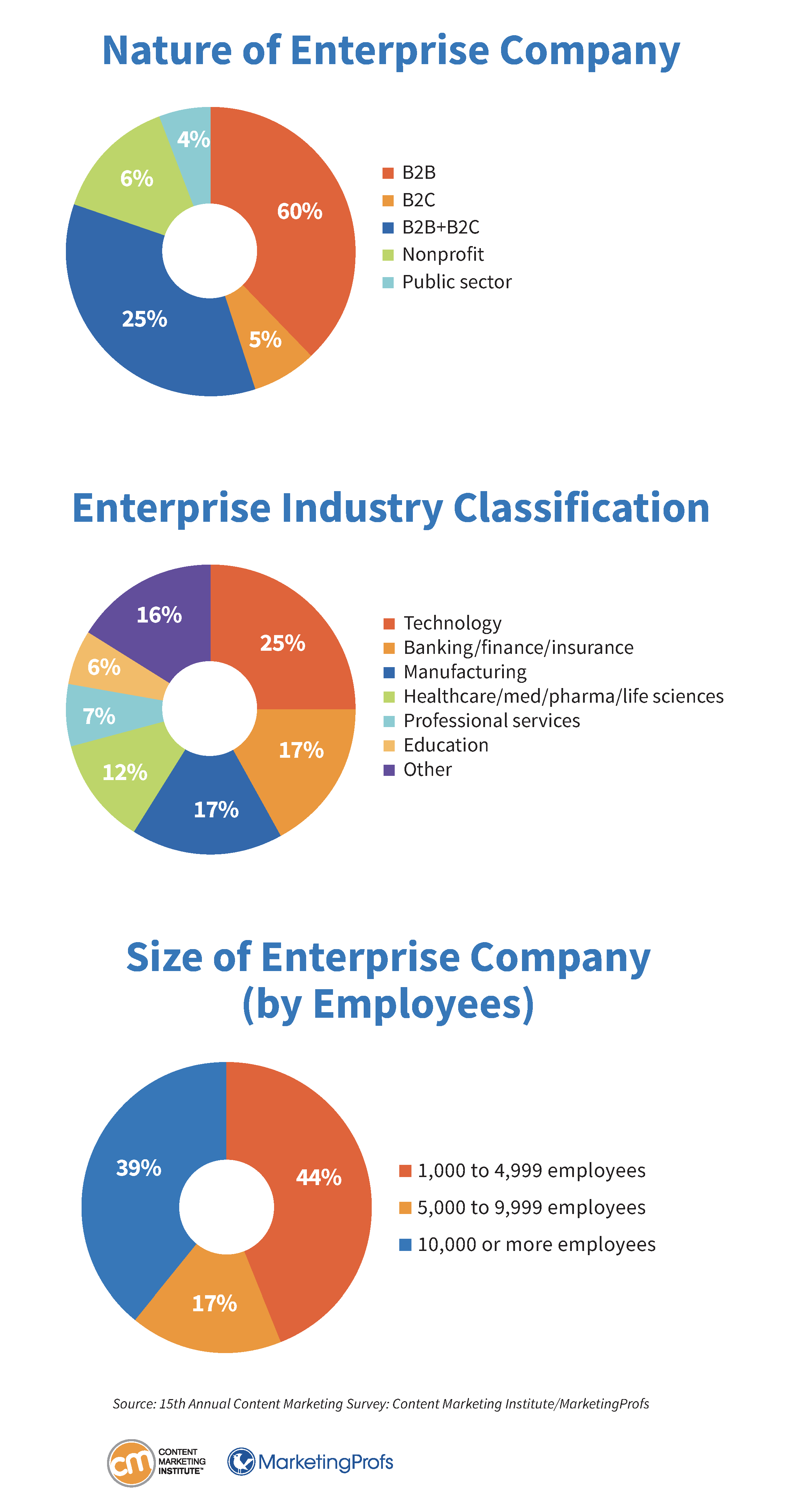
Thanks to the survey participants who made this research possible and everyone who helps disseminate these findings throughout the marketing industry.
Get the latest Content Marketing Institute research reports while they’re hot – subscribe to the daily or weekly newsletter.
HANDPICKED RELATED CONTENT:
Cover image by Joseph Kalinowski/Content Marketing Institute

About Content Marketing Institute
Content Marketing Institute (CMI) exists to do one thing: advance the practice of content marketing through online education and in-person and digital events. We create and curate content experiences that teach marketers and creators from enterprise brands, small businesses, and agencies how to attract and retain customers through compelling, multichannel storytelling. Global brands turn to CMI for strategic consultation, training, and research. Organizations from around the world send teams to Content Marketing World, the largest content marketing-focused event, the Marketing Analytics & Data Science (MADS) conference, and CMI virtual events, including ContentTECH Summit. Our community of 215,000+ content marketers shares camaraderie and conversation. CMI is organized by Informa Festivals. To learn more, visit www.contentmarketinginstitute.com.
About MarketingProfs

MarketingProfs is your quickest path to B2B Marketing Mastery.
More than 600,000 marketing professionals worldwide rely on MarketingProfs for B2B Marketing training and education backed by data science, psychology, and real-world experience. Access free B2B marketing publications, virtual conferences, podcasts, daily newsletters (and more), and check out the MarketingProfs B2B Forum — the flagship in-person event for B2B Marketing training and education at MarketingProfs.com.
About Storyblok
![]()
Storyblok is the headless CMS for marketers and developers who want to make a bigger, faster market impact.
Developers thrive with the freedom to build better, faster, more flexible content experiences using their chosen tech stack. Marketers move with agility and independence, effortlessly editing, personalizing, and publishing content across every channel.
And customers? The seamless content experiences keep them engaged, delighted, and coming back for more.
Join legendary brands like Adidas, T-Mobile, and Renault in making content management fun and collaborative. Explore the possibilities at Storyblok.com.
